#also i want marc to push him over and mount him
Explore tagged Tumblr posts
Text

handsy..
full here
#rosquez#myart#also trying the thing where u save as draft and link to the full?#this pic shouldn't rly set off the filter cuz nothing's showing but it's spicy!#vale's weird gangly old man body has bewitched me i even love his receding hairline u_u#also i want marc to push him over and mount him#boiled silk iykyk#motogp
185 notes
·
View notes
Text
Going Really Big At The Bigfoot 200
I’m only 165 miles in. Still more than 40 to go. Pain shoots up through the bottoms of my feet. Every step feels like the trail is covered in broken glass, but it’s just the early stages of trench foot setting into my waterlogged soles. For the last half hour I’ve been practicing meditative breathing—in throoough the nooose, outttt throooough the nooose—just to take my mind off the shudders of pain rippling through my body.
I might hyperventilate.
I’m so deep in the pain cave, I’m not sure where the entrance was. And it’s very, very dark in here.
Just then, a realization washes over my body—a glimmer of hope. I pick my head up and croak at my pacer, “Hey Marc, I just had a pleasant thought.” “What’s that?” “At least I never have to run Badwater now.”
Who needs some sissy 135-mile race when you can go 206.5 instead, right?
Of Course
My obsession with the Bigfoot 200 started the moment I crossed the finish line at Western States in 2016. States is the granddaddy of 100-milers, after all, and I had just executed a nearly flawless race. It felt like the culmination of something. No 100 will ever come easy, but it felt like I had figured them out. I needed something that scared me again.
And that’s how, one Friday morning in August, I find myself standing at a starting line in the middle of a remote section of the Cascade Mountains in Washington state. My mind is remarkably calm. There’s nothing to be nervous about; who can predict what’s going to come over the next 206.5 miles and 86,000 feet of elevation gain? I just have to let it happen at me. And it’s about to.
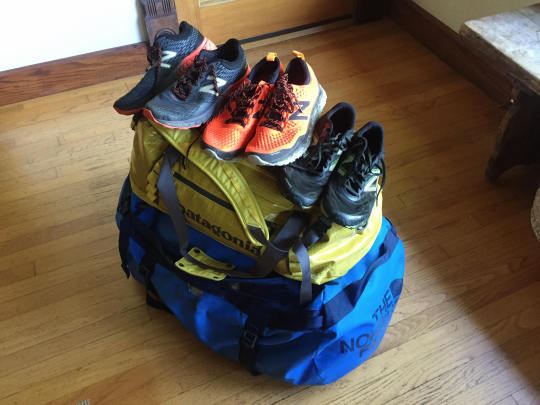
What it takes to run 200 miles apparently.
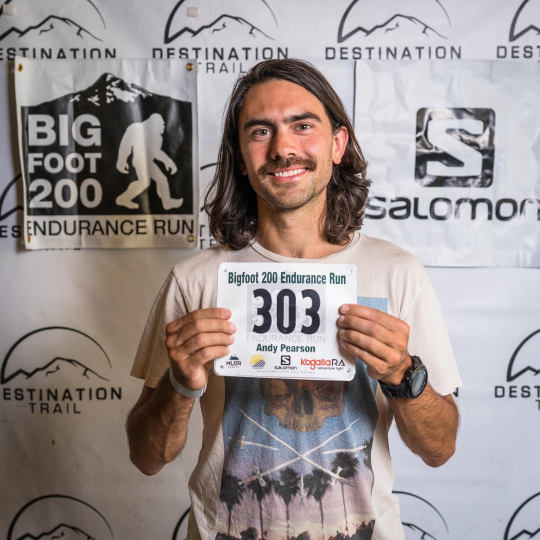
All smiles... at check-in. (Howie Stern)
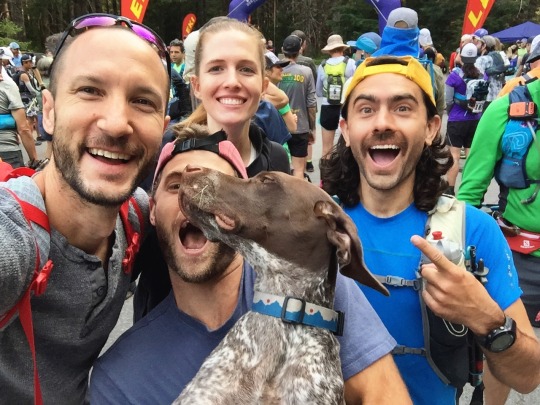
My amazing (and still fresh-smelling) crew: Peter, Erin, Marc, and one big ole puppy. (Peter Dawson)
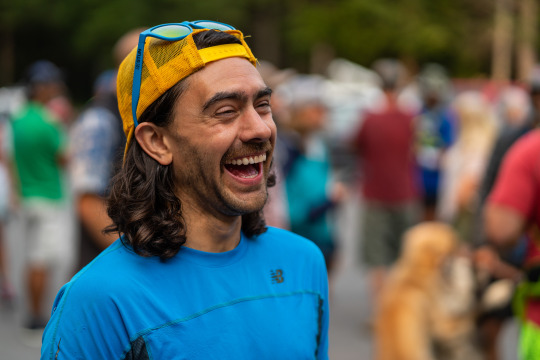
Laughing or crying? Hard to tell. (Howie Stern)
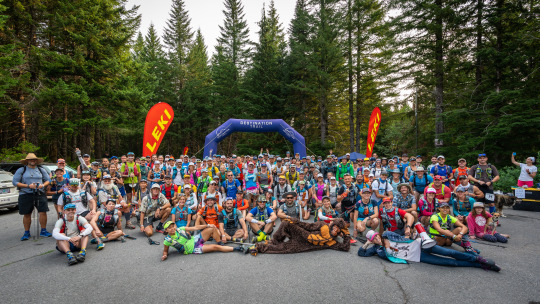
A whole bunch of idiots. (Howie Stern)
3!... 2!... 1!... Go!
A mass of 160-something bodies lurch off the starting line. Within 50 feet, I find myself out front already. Someone’s gotta win. Why not me? I say to myself, a mantra I adopted many years ago.
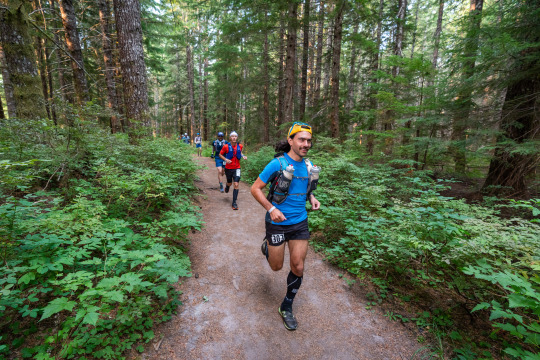
Leading already? (Howie Stern)
youtube
The first miles are generally easy. Soft, dusty trails under a tunnel of pines. Three of us—me, Ryan and Ben—pull out front on our own, chatting intermittently with the standard ultrarunning small talk.
As we break out of the trees and into the volcanic rock, Ryan pulls away. Run your own race, I remind myself. There’s about 200 miles left of it…
We’re on the south side of Mount St Helens, the volcano which famously blew in 1980, instantly ripping apart hundreds of square miles in every direction. Our route will take us through the barren blast zone where little has managed to survive.
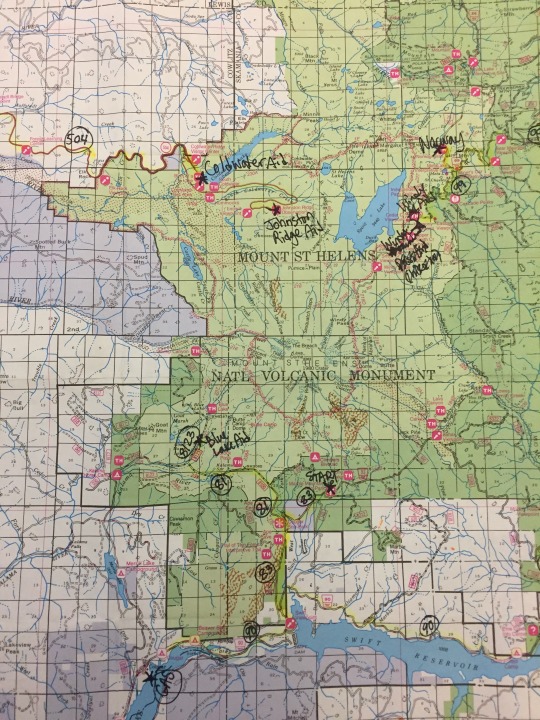
Thar she blows.
As we gain elevation, we enter the field of volcanic boulders. Bubbly, black and sharp, the rocks are a jumbled mess, and I hop my way from one to another, following large wooden poles that define the route. It’s fun, and I nearly slip and slice my entire body open only twice. I’m wearing my trusty New Balance Summit Unknowns. They’re too minimal to go the full distance, but they’re perfect for the nimble scampering I need to do here. My poor gaiters are not as lucky, however. The sharp rock makes quick work of the cords that wrap under my shoes, and soon they gaiters are flapping freely around my ankles, letting in all the dirt they want. I chuckle to myself, Of course.
I make it to the first aid station, Blue Lake (mile 12.2), feeling good, aside from a couple of bee stings I’ve already acquired because, Of course. I fill all four of my bottles, dump ice into my ice bandana and shovel some watermelon and grapes down my gullet. The next section is going to be a long one. More than 18 miles in the open sun.
I’ve caught Ryan, but he takes off so I hurry to follow him. Run your own race, I try to remind myself.
The trail winds us in and out of pockets of forest, mixed with sections of skeleton trees. They stand bare and bleached in the sun—a whole forest of death. Seems like a good sign.
When the trail opens up again, I can see that we’re going to descend down to a big river. I pick up some speed, slaloming down the rutted trail and enjoying the ride.
Suddenly, WHAP!
It all happens so fast I don’t even understand. All I know is that I’m flat on the ground saying the word, “Oof.” I pick up my poles, and one of them dangles in the air like a snapped crab leg. Of course I snapped a pole 15 miles into a 200-mile race. Of course.
Embarrassed but unhurt, I take off again. The broken pole whips around with every bounce. It’s annoying. Finally, I devise a system where I tuck it under one arm while I use the good pole in the other hand. For a brief moment, I feel like Killian at last year’s Hardrock. Except he dislocated his entire shoulder, and you just snapped a pole, I hear myself say. Right.
The course moves clockwise up and around the volcano, and soon I break into blast zone. Vast, desolate, gray and dusty, there’s little life here and even less water. But despite the direct assault by the sun, I’m moving well and feeling good.
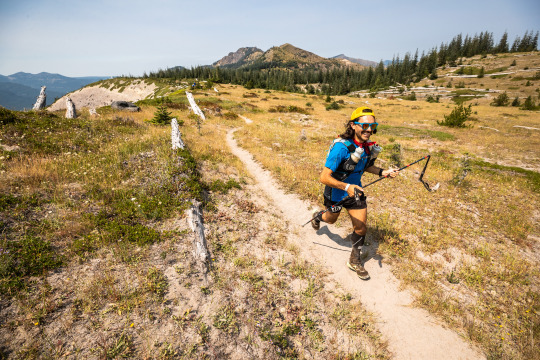
Of course I broke a pole 15 miles in. (Scott Rokis)
Things are strange out here. I discover an insect I name the Sprinkler Bug because, well, I that’s what I thought it literally was at first. It chirps just like those lawn sprinklers that spin slowly and then come back fast. Tct, tct, tct, tct, tct, tctctctctctct! At another point, we climb switchbacks up a massive ridge of soft gray dust. I’ve never been to the Moon, but now I don’t need to.
I’m rationing water now. I still have miles to go before the aid station, but my 80 oz is running low. The race directions said something about a water source at mile 16 of the section; I’m just praying I’m close.
A half mile later, I hear something glorious: water. Coming around a curve, I spy a grove of plant life bursting from the rocks. I break through it to see a tumbling waterfall. “Oh-ho yeah!” I exclaim involuntarily and out loud. I pull out my Katadyn filter bottle and greedily begin guzzling water. It’s so clear and cold I nearly get brain freeze. It’s a proper oasis in the middle of a desert.
After dunking my hat and bandana in the glacier-fed water, I bound off with new life. Eventually, the trail hits a dusty fire road, and I begin to climb up on my approach to the Windy Ridge aid station (mile 30.3).
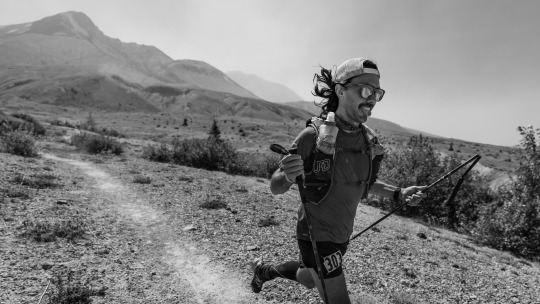
Pole still broken. Because of couse. (Howie Stern)
“Can anyone do some surgery on a trekking pole for me?” I ask as I blow in waving my janky broken pole around in the air. No one seems to want to really be responsible for this fool’s errand, but eventually someone finds some duct tape and gets to work. I know there’s no way they’re going to be able to make it functional; it’s fully snapped in one place and smashed in another. But seeing as I have no crew for another 10 miles, I just don’t want it whipping around anymore.
The duct tape job is so bad that it’s funny. The poor volunteer has created a splint from a spare—but not straight—stick which is then wrapped in black duct tape a few dozen time. The effect is that my pole has grown a malignant tumor. But it’ll do the job. I shove a few potato chips in my mouth, thank the volunteers for their help and bound off.
The Chase
There’s a short out-and-back to get to the Wind Ridge, and by the time I complete it, I come to a confusing sign directing 200-milers to turn right. But there’s no right turn, just desert. Hmm. I run a little more until I come upon Ryan. He’s standing in the trail waiting for me. “I guess we go this way?” he points to the trail we’re on. It’s not a full right turn like the sign suggested, more of a very gentle branch. But we decide it must be right and take off together.
Ryan and I share the next set of miles together, picking up our standard ultrarunner chatter again. We cross washes, bushwhack through dense underbrush and just start to bake in the sun a little. Turns out he’s doing the Triple Crown (Bigfoot 200, Tahoe 200 four weeks later and Moab 240 three weeks after that). Now I’m really impressed but also a hair confused why he’s running out front like that. No mind, we push on.
The trail eventually begins to climb up as we point towards the observation point and our next aid station at Johnston Ridge, mile 39.9. I start to get a little wild hair and think, Eh, let’s push it. I ramp up my speed and start to leave Ryan. I find that being able to come into aid stations ahead of other people is a huge mental boost, for me and for my crew (which in turn is another boost for me).
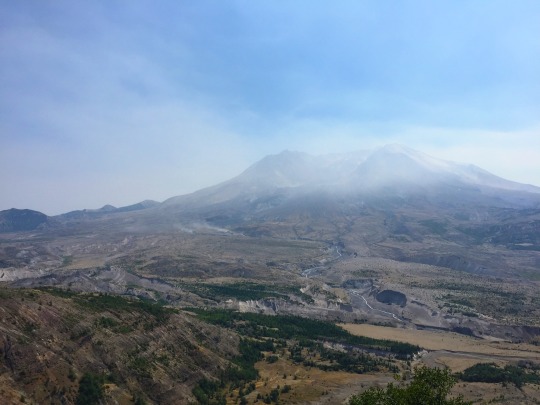
The view of Mount St Helens and the blast zone, from Johnston Ridge. (Peter Dawson)
I get into the aid, grab a hunk of watermelon and find my godsend of a crew, Marc, Peter, and Erin, for the first time in 40 miles. “Wow! You look amazing!” they tell me. “I’m having fun.” “You’re blazing out there!”
“I’ve got an assignment for you guys. You think you can do some surgery on this thing?” I hold up my sad, dangling Z-Pole. Everyone stares at it. Yikes. Finally, Marc offers a solution, “Hey, I’ve got a pair of adjustable Lekis. Why don’t you just take them?” He shoves them into my hands. They’re new, pristine, never been used. I feel bad sullying them. But I think it’s about my only option if I want to finish this thing. God bless you, Marc.
I munch some pretzels and we change out my Summit Unknowns for my cushier Hierro v2s. They’re the biggest shoes I’ve ever run in, but I’m crossing my fingers that they’re going to save my legs because #166milestogo.
By the time I’ve switched shoes, figured out the new poles and fixed my fussy SPOT Tracker we’re all required to carry, Ryan has taken off ahead of me. I wave to my crew and the volunteers and go to chase him down.
It’s now late afternoon. The sun is high and the trail exposed. I’m pushing the pace to catch back up with Ryan, and I think to myself, I don’t remember it being this hot a few minutes ago. Maybe I’m pushing too hard.
I’m starting to question myself when I see Ryan a few switchbacks below me. I lock in and start careening downhill. It’s a little surprising how quickly I catch him. He sort of grunts a nice “Hey” at me, and I realize he’s hurting. And with that, I’m gone.
Over the next few miles, bodies of several 100Kers litter the trail. It’s hot, and the distances between aid stations are too long for inexperienced runners. Poor 100Kers.
I saunter into Coldwater Lake aid (mile 46.5) feeling good. Really good. I’ve been looking at my splits, and I’m almost an hour up on course record pace. Did not see that coming.
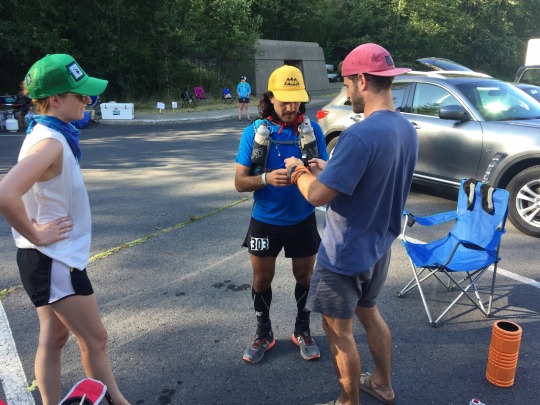
Getting prepped for the first night already. (Peter Dawson)
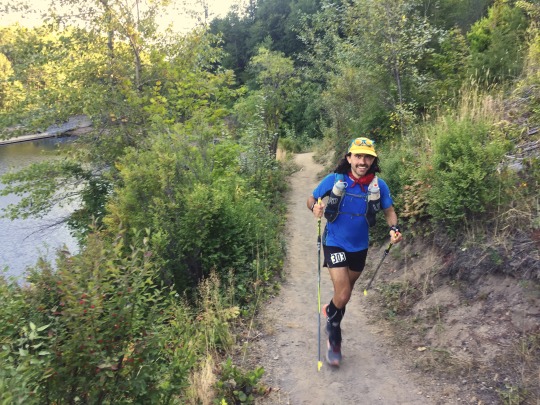
“Hi, Peter!” (Peter Dawson)
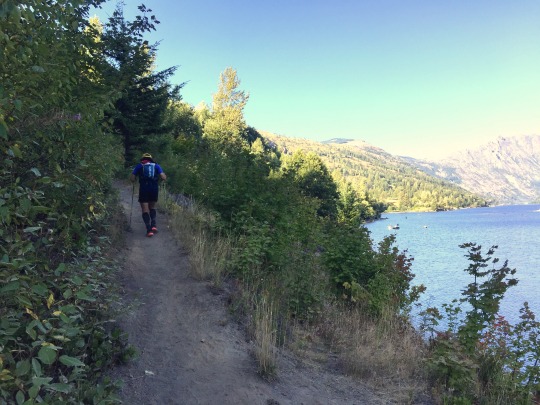
“Bye, Peter!” (Peter Dawson)
Headlight in pack, I roll out. This section to Norway Pass promises to be one of the hardest—20 miles, more than 5,000 feet of gain, all as the sun sets. But for now, I’m just enjoying myself. The trail follows the length of Coldwater Lake, and the trees give me reprieve from the heat that’s undoubtedly out there in the sun. Life is good.
After what feels like a few miles, I cross a bridge and start heading up switchbacks. Ah, the climbing begins. All along the trail bushes of various wild berries burst open. Huckleberries, blackberries, raspberries, thimbleberries. I pluck their gifts as I go hiking by. Natural trail magic.
Eventually, I top out and find myself high above the landscape below. The sun hangs low in the sky, and the trail snakes its way under ridges and peaks. Up and over a crest and suddenly the whole of Mount St Helens is laid out in the distance. The volcano has her own ring of clouds clinging to her. And in the golden hour, everything glows amber. I’m totally gobsmacked. I turn another corner and suddenly Mt Adams comes into view in the far distance too. My insides ignite with pure joy. It’s hands-down the most spectacular sunset I’ve ever witnessed. And I have it all to myself.
I’m totally alone for miles and miles. Up here. I’m on top of the world. I slow down and breathe it in.
Continuing on, alpine lakes unfold below me, hidden from the rest of the world behind a fortress of peaks. A third of their surfaces are covered in white. For a moment, I don’t understand what I’m looking at. Then I realize it. They’re massive tree trunks, bleached in the sun. The lakes are covered in them. They must be from the blast, killed off decades ago and left to float on the lakes. I know I’m the only person who will see these tonight, and I feel immensely lucky.
Just then I hear a screech. It’s high and sharp and echoes off the mountains. There’s only one thing it can be. Mountain lion. Oh heeeey.
The sun sets at 8:25, but I’ve always liked to run in twilight so I keep going without my headlamp, seeing how far I can get before absolutely needing it. Turns out I can make it all the way to 9:00. OK, I’ve tempted fate long enough, I say to himself as images of me eating shit in the blackness play in my brain.
Headlamp on, I top out again and seem to be heading downhill. There’s a quick out-and-back to tag the Mt Margaret peak. I’m sure it’s lovely in the daylight. In the dark, it’s mostly just very dark.
I careen downhill, eager to make it to the next aid. Finally, a faint light appears in the valley below. I remember a race report saying that the aid would be visible but still very far away. But after what feels like a few miles, it’s still very far away. Maybe that’s not it? It’s the only light I see out there in the inky night. But is that really it? After what seems like an eternity of “Guess-If-That-Light-Is-The-Aid-Station” I come upon a sign that reads “Norway Pass 1 mile”. Guess it is. And it’s still kinda far away.
Another down in and I come into Norway Pass aid station, mile 65.2. After being alone in the dark for so long, the sudden buzz of activity and light is a little shocking. Someone brings a blanket—it’s getting chilly now—and I request a cheeseburger and Coke.
There’s a boy of about six years old who’s very excited to see me. “I said he was going to be here soon, and then he showed up!” he keeps repeating proudly. “I said he was going to be here soon, and now he’s here! Do you want chili? Coffee?” He flitters around me like an overly excited mosquito.
For a moment, I think of my own one-year-old boy at home, and I’m taken out of the race. Watching this kid bounce around, I think to myself, One day my baby will grow up to be a super-annoying little boy, just like this one.
Into The Heart of Darkness
Burger in belly, I shove off again. The trail out of Norway is in bad disrepair. Bushes obstruct the trail and dead trees lay littered everywhere. At one point, the trail seems to dead-end into pure forest. I stop, feeling it’s wrong, but go ahead and push my way through a mess of pines. After 20 feet of thick bushwhacking, I turn around. I try a different entry point and push through. Another 15 feet and nothing. I turn around again. I try a third time, but nothing. This seems bad. Finally, I turn around and look behind me. There’s a hairpin turn in the trail at about a 350-degree angle. A ribbon sits squarely but invisibly in the middle. Ahh. In my frustrated state, I can’t remember which way I’ve come. Or more importantly, where I’m going. Everything starts to look the same. I pick the right side and start going. But it feels weird to be going uphill. I stop and turn around to try the other direction. I make it a little way down this direction before I see something familiar feeling. Now I’m very confused. Stop. Breathe. Think. I pull out my iPhone and switch it on. We were required to load the race into our Gaia GPS app before the race. Thank God. I look at it. Yep, I’m definitely going the wrong way. Score one for Gaia.
Heading back in the right direction, I start to feel better. The trail improves, and I enjoy some night miles once more.
The trail seems to be crawling with all kinds of thing. I see toads hop away from my feet. Salamanders wriggle under leaves. And bugs of all kind squirm everywhere. I’m not having hallucinations, but my mind starts to play a game where it makes faces out of every leaf or rock I step over. At one point, I look down a see a rock that’s clearly Zombie Barack Obama.
I’m enjoying my time so much that I forget the last time I saw a marking. They’ve been spaced rather far apart, but, Maybe I just haven’t been paying attention? I keep going, suddenly on high alert. Nothing. The trail begins to climb. A lot. For some reason, that doesn’t feel right. My hands are on knees as I’m pushing uphill. Where is the damn marking? I’m starting to panic a little again. But, foolishly, I keep going. The markings HAVE been really far apart, I convince myself, not wanting to admit what I’m fearing.
Stop. Breathe. Think. Common sense finally appears. I stop and pull out Gaia again. I’m off-course. By a lot. Somehow I’m on a parallel trail to the correct trail. (Unless GPS is placing me slightly off, and I’m really on the right trail?) I wonder if I can connect to the right trail if I continue, but that doesn’t seem likely. What if I bushwhack? Dense brush, going fully off-trail, not a good idea, my common sense rebuts. The only option is to turn around. So I do.
It takes me a long time to get back. At least 15 or 20 minutes. I’ve probably added a minimum of two miles to my race by the time I get back to what Gaia tells me is the proper trail. There, I find a three-way intersection. I see flagging uphill, where I came from originally. And then I see a flag pointing down the trail I’ve just backtracked on. Meaning, according to that flag, I was on course. But my Gaia is telling me otherwise. I look off to the only trail I haven’t gone. No flagging, but Gaia says it’s right. I cautiously proceed, wondering what the hell is going on. Confusion mixes with anger with just a dash of annoyance.
A ways down the trail, I finally see it: a flag. Finally. A little farther, another flag. Farther still, another flag. OK, I must be on the right trail. It starts to dawn on me that the flag pointing downhill at the intersection was placed incorrectly—maybe by a bad course-marker? But by then, I’ve already gone too far to turn back and fix it. I’ve already added enough extra miles tonight.
The side effect of the episode is that now I’m super paranoid. Suddenly I can’t trust any marking. Any time I go more than a couple of minutes without seeing a ribbon, I start to freak. The forest suddenly feels a little more sinister.
That’s right when a bird hit me.
It flies right smack-dab into my chest. OK, weird.
A few minutes later, I hear something directly off to the right side of the trail. It sounds big. Like, pretty darn big. But thinking it’s just a deer, I don’t worry, and it seems to disappear. Fifteen seconds later, I hear it again, it’s directly off to the right. Still. It’s paralleling me. I hear it crashing through the underbrush, still precisely off to my right. IS THAT BIGFOOT??? Objectively I know it’s not, but also, I mean, the race is named for him. Now I’m proper freaked. I begin shouting and singing nonsense, hoping Bigfoot hates my voice. He must because I don’t hear him after that.
It begins to rain now. Just a little. But enough to make the trail slick.
I enter a small, narrow canyon with the trail built onto a shelf. Or at least that’s the best I can tell from the beam of the headlamp through the rain.
Suddenly, through the darkness I hear, CRACK!
Holy shit, there’s lightning now??
The thunder sounds as if it struck just a few hundred feet to my right. Then I think, Wait a second. There was thunder but no lightning. That’s weird. Then it dawns on it. That wasn’t lightning; that was a tree falling. OH GREAT. I look up suspiciously. THE ENTIRE FOREST IS READY TO FALL DOWN AND KILL ME. If I was paranoid before, I’m out of my mind now.
Finally, mercifully, I make it to Elk Pass aid at mile 76.3, alive. I immediately start blubbering about the trail marking fiasco. “It’s somewhere near Badger Peak,” I tell the aid station captain. “Oh, I know exactly where that is. Same thing happened last year. Someone vandalized the course.” “Oh man.” “Yeah, these stupid local kids on dirt bikes go out there and switch up the markings. Think it’s funny.” It’s a bit of relief to know that it wasn’t my fault. But also, what the hell?
I sit down to regroup and eat some more real food for the first time in hours. As I do, someone asks if I saw any wildlife out there. “Uh, well, I heard a mountain lion, got hit by a bird and am pretty sure I was being hunted by Bigfoot.” It feels good to have a laugh and know that all that’s in the past.
The good news is that I’m still well up on my splits. The course record feels within reach. I’m going for it. I wave everyone farewell and head out.
But the stress of the night has taken its toll. I feel worked. A cold is slowly materializing in my chest and nostrils, adding to my general feeling of shittiness. Not only that, I’ve been relying on gels between aid station stops for most of this first day, and they don’t seem to be giving me everything I need.
The trail rolls, then climbs. I start to feel a little foggy. It’s now very, very early morning, that magical time when things get weird in a race. Fifteen miles to the next aid and my first pacer. I just have to make it.
Things get colder too. This is not fun anymore. A deeply awful feeling suddenly washes over me. This is impossible. It’s too much.
A terrible idea takes root: I’ve just run 70 miles. I HAVE TO DO THAT TWO MORE TIMES. All that I just did. Again. Twice.
The flame that’s been burning inside me suddenly extinguishes. Poof.
It’s not that I don’t want to finish; I just don’t know how. It’s just not possible.
It’s a black pit. I’m standing at the bottom of the Dawn Wall, staring up, no rope, no clue what to do. That task in front of me does not compute.
This is impossible. It’s just not possible.
It’s the first time I’ve felt like dropping in years and years. But it comes on so suddenly that I feel like I’ve been punching in the gut.
I begin formulating my exit plan. When is it OK to drop? Where can I drop? What will that feel like? How is my crew going to feel? The last question hits me. I realize how shitty it will be if I asked them to take off almost a week of their lives to come out in the middle of nowhere, just to have me drop. I start to feel really bad.
You feel bad for them? What about you?? a voice asserts. Just think of the time and training and preparation and—screw it—MONEY that YOU put into all of this? It’s true. It’d be pretty shitty to just give up this easily.
Plus… the voice winds up for its final knockout punch. There’s a pause.
Yes?... I ask.
You know you’ll just have to come back and run this again if you drop.
Shit. I know it’s right. And I am not about to come back and run this dumb race again. No way.
And with that, I resign myself to finishing. I’m back in.
I top out of the climb and beginning rolling downhill. In the fog—both metaphoric and literal—my legs work at an embarrassingly suboptimal pace. Picking my way down the rutted-out trail, I finally reach the bottom and spill onto a dirt road. I’ve made it to the mile 91.3 aid station, Road 9327
Marc, Erin, and Peter are there. “I need to sleep,” I announce. They hurry me into the back of the rented Suburban. Mercifully, I rip off my dusty shoe and slide into the trunk. “Get me in 15 minutes,” I mutter as they shut the Chevy-branded sarcophagus on me.
I close my eyes, and all I can feel is cold and the ribbed, plastic bed of the truck on my back. I shift left and right. Nothing makes me feel as sleepy as I know I should feel.
I remember advice from my friend Bryce who said he wasted an hour trying to fall asleep last year. I’m determined to not let that happen. After ten minutes of bullshit, I sit up. My caffeinated gels must be working a little too well. I knock on the window and beg to be let out. Oh well.
By the time I’m out, my breakfast is ready. Eggs, bacon, coffee. It’s glorious. I scarf it greedily. It’s amazing. Then it dawns on me: I need to switch to real food. These formulated gels and chews can only do so much for me. If I’m out here for two and a half days, I need good stuff on my stomach. I ask them to whip me up a quesadilla to go.
Day Two Dawns
Reluctantly, I strap my shoes back on. Time to go. At least I have Marc with me now. We say goodbye and amble down the mountain farther. The morning light filters through fog, and things feel a little better. We chat and catch up. It’s nice to share miles with someone again.

Meanwhile, back in the crew car... #vanlife (Erin Gardner Dawnson)
Marc has downloaded the course onto to his InReach. After a bit, he announces, “OK, I think we have this climb and then we head down to the aid.” We climb for a while longer. At one point, in the total middle of nowhere, we come across some senior campers out for a morning stroll. “You guys out for a running? Doing the one-mile loop?” We just stare at them, unsure how to answer. “No, we’re not,” is the only appropriate answer that comes out.
Marc checks his GPS again. “I think it’s just this climb again.” This climb seems to have been going on forever. And then it keeps going even more. And more. It’s getting steeper too. I have zero recollection of reading about a monster climb here in any course description. “Dude. What the fuck.” This thing does not end. I look up and only see more climbing. We keep telling ourselves that it must top out at the next bend. But every time we hit a turn, we look straight up another half-mile of trail. The cursing becomes more frequent and emphatic. Marc keeps promising that we must almost be there, but every time, I wind up heartbroken. Things start to feel impossible again. At some point, I cross the 100-mile mark without fanfare; I don’t even notice until much later. One hundred miles in 25ish hours. Fast for a 200. But a sub-24 had a nice ring to it.
After what seems like five times too long, we reach the top of Spencer Butte. (Or Spence Butt, as I’ve obviously named it.) Rather unceremoniously, we drop off the top and down towards the aid. It’s a long descent, but not nearly as long as the climb. Ragged, we pop out onto a paved road and the aid. Mile 102.5.
I sit, regroup myself a bit, eat some more food and then off we go. Marc and I patter down the paved road. In the sunlight, I don’t feel terrible, but I don’t feel good either. After two miles, we see the turn-off, a small foot trail that seems to drop precipitously off the side of the mountain.
“Is this even a trail?” Marc wonders aloud. We switchback down a very steep descent, covered with leaves. It’s a screamer. “I think the last time anyone used this trail was last year’s race,” Marc says. “Agreed.” But it feels good to be running again.
Eventually, we bottom out and snake our way towards the Lewis River. And civilization. We cross a road. We start to see cars, hear people, catch tents. After spending the last day in the backcountry, the sudden assault of other human beings is a shock to my system. People who have no idea what I’ve been through or what I still have left to do. Just people merrymaking and lazily cooking eggs over campfire and walking down to the river to get a glimpse. Their presence energizes me a little. After all, people equal an aid station nearby, right?
Marc and I hit a well-trodden path that parallels the river, running upstream. The water looks crisp. I fumble to get some orange-flavored Honey Stinger chews into me.
We must be getting close, I think to myself. Then I say it out loud. “We must be getting close, right?” Marc checks his InReach. “We have a little ways to go.” “OK.” We wind inland some, away from the water. Surely we’re headed into the aid. I ask Marc again, but he only deflects and tells me we have a few more miles to go. My optimism starts to sour. Somehow I’ve conflated the mileage of different aid stations in my head. I’m confused. The trail continues to roll. We head along some cliffs, hear a waterfall, pass more day-hikers. I grunt to acknowledge them. In my head I imagine myself to be a small slobbering hedgehog of a creature. It’s probably funnier in my head than it actually is.
Finally, after what feels more eternal than the previous eternity, we see a sign telling us that the Lewis River aid station (mile 112.1) is a few hundred feet away. There’s a series of signs, a Caribbean theme I think. I recognize a Jimmy Buffett quote, I think.
I throw myself into the folding chair. I made it. Well, I made it to halfway-to-making-it. At least I’m still in the lead, I assume, by a considerable bit. Nevertheless, I want to get out there quickly. Or, rather, I want to want to get out there quickly. It feels good to sit. It’s morning, and I’m eating chili. I change shirts. We wash my feet. I have a long debate with Peter and Erin about whether to change out my shoes to the next half-size up for swelling but ultimately decided against it. Then, I brush my teeth. Oh God. It feels so good. I’d been looking forward to that for about 100 miles now.
I’m patched together as best I can. I feel like spare parts, but at least I’m still well in the lead. With a wave, I amble out of the aid station, back down the hill and past the possible-Jimmy-Buffett quote signs, with Peter now in tow. Just as we near the turnoff to get back on route, a thick bear of a dude comes flying up the trail towards me. He flashes a smile and says hi. I’m dumbfounded.
We turn onto the trail, and then I turn to Peter. “That can’t be another runner… right?” “I don’t think so, man…” “I mean… I don’t think that was one, right?” I get a little more uneasy.
We drop down by Quartz Creek and begin following a trail that’s only slightly better than a game trail. At times, the trail turns and shoots straight up the hillside, leaving us clawing our way up, hands on knees. Then it inexplicably turns down and drops again. Then up and down and up and down, without purpose. It's beginning to feel a little maddening. Then again, I realize, it’s sort of a metaphor for this whole thing, isn’t it?
Rain begins to fall in spits. It cuts the air pleasantly, and I allow myself to enjoy it. But after a few minutes, I realize I’m starting to get soaked. No bueno. I stop to slip on my rain shell.
A few minutes later, we hear a sound over our shoulder. Within a minute, that same bear of a guy we saw coming up to Lewis River aid, goes shooting past us. “Nice job, guys!” he hollers as he sails off. Gut punch. He really was a runner after all—Wes Ritner, I learn later. Well, there goes that. I’m sad but mostly just jealous of how well he’s moving. Within two minutes he’s out of sight.
The rain subsides, and we keep up-and-downing our way along the creek. Finally, we get to a crossing point, likely the last water for another 15 miles. Peter and I stop on a jumble of rocks to filter water into our bottles. I look around at the forest, the creek, the two of us sitting there, and it feels just really pleasant. If I wasn’t 118 miles deep into a race, we could just be two friends out a little adventure hike. I savor the moment. The weight of leading the race has slid off my shoulders finally. Now I just want to finish.
We drink our fill, top off bottles and then press on. Several minutes later, as we’re picking our way through thick, razor-like thorn bushes, we hear a crashing sound behind us. It’s Ryan from before. And he’s flying too. He says a quick hello, asks if I’m OK—Geez, do I look that bad? —and then shoots off uphill.
The next few hours feel like more wandering. We claw our way uphill on the “trail” only to drop back down again moments later. It feels pointless, and I become angry with whoever designed this stupid, stupid trail.
Soft rain falls off and on, and I foolishly feel grateful for the change of pace. But it starts to chill as we make our way up to some road that’s supposed to materialize yet never does.
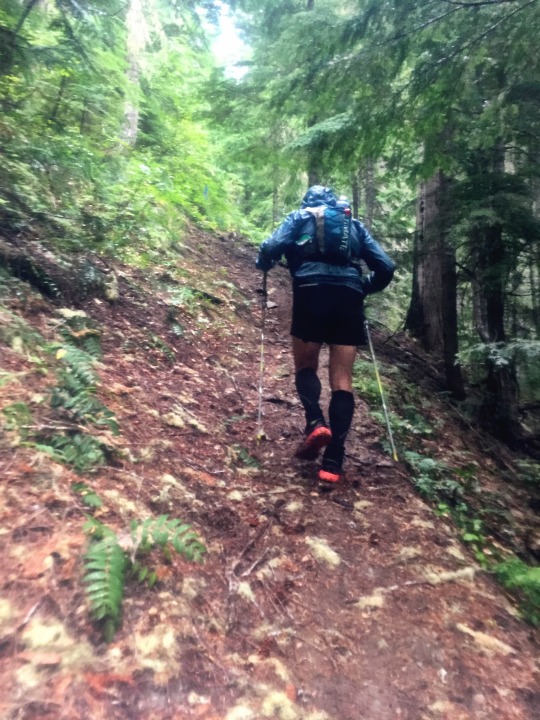
Pretty par for the race course. (Peter Dawson)
I’m starting to feel truly, deeply exhausted. I want proper sleep. “I’m going to lay down to sleep once the sun goes down,” I announce to Peter. I check my watch. It’s 6:28. Sundown is at 8:00. I can’t wait till 8:00.
We finally reach the dirt road high up on a ridge. It’s a mess. A combo of rains and ATVs have torn it up, in that annoying way that ATV tear things up. But I’m happy to be making progress at least. The late summer sun shines through the wet trees, bathing us in golden light. I’m starting to stumble a bit.
I keep checking my watch. 7:41. 7:46. 7:52. 7:55. 7:57. Finally, it’s 8:00. I can officially sleep, based on my totally arbitrary designation. I begin hunting for a spot to lay down, but the rain has soaked most of the ground. After another few minutes, I spot a small dry patch behind an island of trees in the middle of the trail. Sleep time! I take my pack off, make a little pillow with it and lay down. The dirt is lumpy but soft. I can’t wait to sleep.
ZzzZzzzzzZZ! Smack!
ZzzzzZZZzZZzZ! Smack!
ZZZzzZzZZZ! Smack smack smack!
Shit. Mosquitoes. Really??
I’m absolutely swarmed in mosquitoes. They assault every square inch of exposed, short-shorts flesh. I swat them in vain, convinced I’ll still sleep. My legs and arms are pricked and pierced mercilessly. Shit.
I dig into my pack and produce a long-sleeve shirt which I lay across my legs like some sad pair of pants. It obviously does not do the trick at all. I toss angrily. I give one more valiant effort to ignore the pest, but nothing is going to stop this assault. “It’s not going to work,” I tell Peter, sitting up. “Let’s keep going,” I say, defeated.
We arrive at the Council Bluff aid station (mile 131) in the dark. It’s starting to get cold, and I’m starting to feel properly wrecked. The cheery aid stations folks can tell. They plop me under a blanket near the fire and someone offers me chili. “Sure, thanks.” They bring over a paper bowl lined with a flour tortilla and then covered in a very corn-forward chili. The tortilla-under-chili thing confuses my brain, but I eat it greedily as best I can.
“Alright, I want to go soon,” I tell Peter. If I can’t sleep I might as well keep moving. Chain of Lakes is less than 10 miles away, with all my stuff and another chance at sleep.
“Hey, you need to eat some more,” a volunteer comes barreling over to me.
“I’m good, really. I just want to keep moving.”
“No man, you need to eat more food.”
“I have been eating.”
“Listen, dude, I’ve run a lot of races. I’ve DNF’d before. You need to eat more.”
Weird flex.
“I don’t. want. food. I want to go.”
“I’ll get you some M&M’s.”
“Dude. I’m good.”
He continues to brag to me about running a 36-hour 100-miler or something. I guess if he’s trying to prove his prowess at being bad at ultras, I'm convinced. Either way, he won’t let me leave, and I’m starting to get really annoyed. The other volunteers can sense the weird scene unfolding. One of the volunteers offers, “How about some Oreos?”
I can sense that this woman is just trying to help me get out of here. “Sure,” I acquiesce.
I leave annoyed, with a paper towel sleeve of three Oreos, muttering to Peter.
The next hours drift hazily at best. We roll along, just trying to bide our time until Chain of Lakes. My head cold from before has fully bloomed into something serious. I shoot snot rockets from my nose every few minutes, and it’s getting harder to breathe. Cool.
As we climb up to a paved road, there’s a promise of civilization. Road signs tell us of Takhlakh Lake and its campground nearby. I assume that it’s part of the Chain of Lakes so we must be close. Really close.
Along the sides of the road, we see white frost delicately forming. It’s frigid and exposed on the road. We slip on gloves and await the aid station’s arrival. But instead of turning down the obvious road to what had to be the aid, the flags point us past and then turn off the road entirely and into the woods. It must just be a quick jog through the woods to get to the aid on singletrack, I think. But the aid never comes. Peter looks at his watch and tells me it must just be another half mile. But that passes. And passes again. And we’re still not there. I can feel despair setting in again. I foolishly say I’ll wait to eat food till I get to the aid station because we must be so close. When too much time passes, I fully stop in the middle of the trail to eat. My bar is rock hard in the cold.
Just then, we see lights. Within minutes, Jordan Chang and his pacer on upon us. We exchange a few pleasantries, and then they scamper off. He looks awesome. I feel like shit.
Ten minutes later, the trail spits us out onto a small road. We’re there, finally. I’m energized by making it this far. One-hundred and forty miles. The aid station is dead. After all, it’s 2:00 in the morning and below freezing. Erin and Marc are excited to see us, and I happily take some soup and quesadillas from the hearty volunteers who have shaken themselves awake on my account. But my focus is sleep. Marc informs me that his puppy has somehow popped the sleeping pad. “I don’t think it’s going to matter, man,” I say, fully exhausted.
I clamber into the back of our Suburban, remove my shoes and socks, slide into the sleeping bag and tell them to get me in 20 minutes. I’m very excited for sleep.
But almost immediately, I learn that I was wrong about the sleeping pad. The trunk of the truck is cold and hard with long, plastic grooves. It’s surprisingly uncomfortable, and the knobs of my bones feel like they’re poking out everywhere. It’s also freezing. I toss and turn, trying to find some position that doesn’t suck. Mostly I’m amazed that I don’t fall asleep. I never have a problem sleeping in real life. I start actively thinking about sleeping. I have to sleep. Yeah, no shit. OK, sleep now. Nothing. OK… sleep now. Nothing. OK, sleep… NOW. This is not looking good.
Just then there’s a bang on the back window. “Hey man.” It’s Marc. “It’s been 20 minutes.”
“Wha?”
“Twenty minutes.”
“Uhh, I don’t think I slept?” It comes out as a question. “Gimme another 20 minutes, OK?”
“OK.”
I return to my latest impossible task. I try to force myself to sleep for another ten or fifteen minutes, but to no avail. Finally, I give up and drag myself over the back seat of the car and spill out the door, shoeless. The gravel in the parking lot is cold and sharp on my battered, naked feet.
My crew seems a little concerned to see me. But I’ve already moved on. I’m just not going to sleep at all I guess. With a little too much effort, I slide on a pair of light tights and a jacket. I guess we’re still doing this…
When Hell Freezes Over
Marc and I give a wave and thank the volunteers before shoving off into the dark. We quickly hit some winding, descending singletrack. It feels nice to be moving well again. Soon thereafter, we hit the first of our three river crossings. It’s 3:00 am.
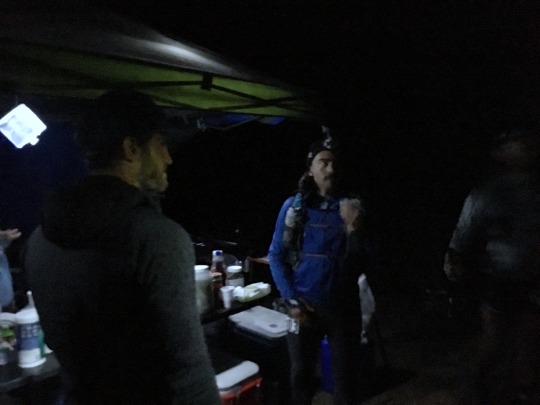
Bundled up for the night. Or so I thought.
The water isn’t high, but it feels glacial. I yelp as I slip my legs in. The cold wraps up to my mid-thigh. A minute later, we emerge on the far other side, water-logged.
The next two crossing come fairly quickly and are equally unpleasant. But at least we’re done with them, I think.
The trail soon becomes a little less distinct, and it feels like we’re meanderingly aimlessly through dense forest. Thick, lush underbrush, heavy with the evening’s rain spills over the trail, and we’re doing whatever one level below bushwhacking is. We continue like this for some time, and I start to realize that I’m getting wet. The water-bedazzled foliage shows no signs of letting up, so we stop to slip on rain jackets.
I’m getting cold. Like, really cold. My teeth start chattering. Then they start chattering really loudly. My body starts shaking. Why is my body shaking? The underbrush doesn’t let up. Neither does the shaking. I start to feel like shit. Like, really not good. This is not good.
Marc pushes on in front of me. As I fall behind, I realize something is very wrong. I weakly squeak out to him, “Hey man, I’m exactly sure what hypothermia is… but I’m pretty sure I have it.”
In the moment, I couldn’t access the file in my brain labeled “hypothermia.” I couldn’t recall what it was. But it seemed like this must be it.
Marc spins around and sees me. Hypothermia confirmed. “Put on everything you have,” he instructs me. I don’t have much more in my pack, but I zip up my rain jacket completely, to that awkwardly high point that rain shells zip to. Only the round of my face peeks out. “Can you eat anything?” I pop a Gu. It’s cold and thick and caramelly and a terrible flavor.
I can barely speak through my chattering teeth. My body spasms violently. We just have to move. Help is not coming. The Klickitat aid station is mile 158.1, almost 20 miles away from Chain of Lakes. I just have to hold on till morning.
We start moving again. My body is revolting against itself. I feel frozen down to my bones. I realize my breath is escaping unused into the air, so I pull my jacket up over my mouth and breath down into it, blowing warmish arm down the front of me. I’m not sure if this is actually doing anything, I think to myself. But at this point, just the fact I’m able to come up with any sort of attempt at a solution feels like a win.
Time passes. The clattering and shaking continue. I eat an extra gel. How does this all end?
Finally, we start to see the first glimmer of morning light in the sky. We hear a bird. Then, another. Morning is coming. We couldn’t have hit the river crossings and wet underbrush at a colder time—the dead of late night—but the day was slowly clawing its way back.
Eventually, my shivering slows and finally stops. I’m still cold, but I feel like I have my body back, at least a bit. I’m still alive. What a weird, horrible dream.
In the morning light, we climb up to an empty paved road. I get that disorienting feeling of seeing something manmade again. Across the road, the trail drops into a forest. We drop down too. I find myself moving decently again. The forest feels huge. Giant redwoods tower overhead. It’s dank and dark. The air hangs heavy with the glorious smell of wet, rotting wood. Green and brown. Everything else that has happened melts away. I feel like I’m in the presence of magic. My mind tries to wrap itself around where we are, but it can’t. The only thing I think of is that we’re truly in the middle of nowhere. I suddenly become very grateful. I’m far out, way far out here.
We wind through the forest for a while before spitting out on a series of dirt logging roads. Their presence feels jarring and blasphemous.
We cross another paved road and begin to climb a hill. A very steep hill. We quickly realize that we’re starting our climb up to Elk Peak. The last test before we reach aid. The thought energizes me a little. I pop in my trusty iPod Nano loaded with music from 2012 and start power hiking.
The high dissipates after a mile, and it’s just really fucking hard again. Then I feel it, a twinge in my left heel. My Achilles. Literally. It’s my nemesis. An injury that’s haunted me for years. I instantly worry. Any weird step and it could be the end of my race. The only upside is that I can’t believe I’ve already gone 155 miles with zero problems. Look at you thinking positive!
I slow down, hoping to be kinder to my stupid leg. The climb drags on. Every time I’m sure that we’re topping out, the mountain keeps going. It’s not just false summits. It’s tiny false peaks that raise before us. First, it’s annoying. Then it’s infuriating. Then, eventually, it’s just hilarious. Our frustration gives ways to pure, hysterical acceptance of our situation. A running joke, about running.
Just as it seems that we can’t possibly hit another false peak, we see another, rocky peak rises in front of us. But this one is different. It’s an out-and-back. Our out-and-back. We scramble up the sheer, angled rock and finally arrive at our goal.
The view is breathtaking, in the truest sense of the word. We’re surrounded by it. In 360 degrees, the Cascades stretch out around us. Dense, green forests. Rocky, gray peak. Wispy, white clouds clinging to them all. I remember the course description, word-for-word. “Look out from Elk Peak at Helens, now so far in the distance. And Adams, once so far away, now so close.” My mind searches to understand what I’m looking at. Adams is right there. And Helens is so far away. I think back to days? weeks? months? ago when I was next to Helens and Adams was so far away. I’ve traveled 155 miles on my own power. How am I supposed to understand that?
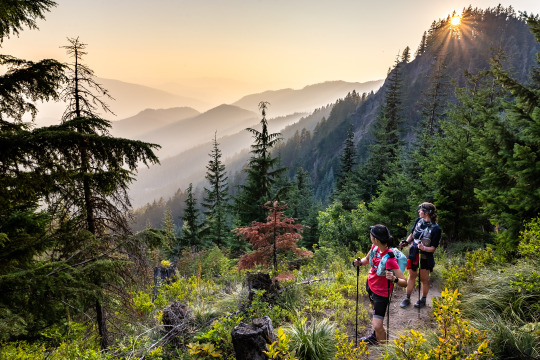
Just a taste of the Cascade, savored by other runners. (Scott Rokis)
I suddenly don’t care about racing anymore. I feel like I’m floating. As we descend of the slightly-sketchy rock face of the peak, another runner and pacer amble up. They’ll pass us on the way down to Klickitat. Oh well.
We bomb down to the aid, getting passed on the way in, of course. I can’t wait to get my still-soaked shoes off for a short respite. They’ve been drenched since the river crossings. Finally, we pop out on a small dirt road in a break from the trees. It’s startling how bright and warm it is. I'm not sure what time of day it is, but it feels like mid-afternoon. But maybe it’s not.
A very nice woman with a thick Eastern-Bloc accent attends to me. We explain the hypothermia and soaked feet, and they lay me up a reclining camp chair. A medic introduces himself and starts to work on my feet. They’re mushy and soft, with deep trenches running through them. He rubs them down with alcohol and sets up next to a gas-powered heat lamp. In the openness of the harsh sun, the heater feels vulgar and awkward.
I sit for longer than I want. But I don’t care. I’ve just been out there for 20 miles. And I have another daunting 20 to go before I see my crew and gear again. Jordan comes in (He must have slept somewhere. Lucky.) He leaves before me. The Eastern-Bloc woman offers to rub down my legs. I don’t particularly want it, but she seems very into it. She spends a lot of time on my calves. It’s getting weird.
After what feels like half an hour, we finally gather our things to leave. My feet are dry now, but despite our best efforts, my shoes are still woefully waterlogged. The moment I slip them back on, I feel the squish. Great. All that’s left to do is keep moving.
We thank everyone for their hospitality and slide off into the forest. The dark, foggy forest has given way to a bright, open one. Hyped on the aid station stop, I feel good, and we start to crank again. We roll through the hills, underneath the ancient pines. Things are looking up.
That’s when the mosquitoes hit. Not just a swarm. A cloud. They descend on us, thick and swirling. Never in my life have I seen anything like this. I swat them away, and I feel like I’m batting at seagulls. They nip at us. We shriek and try to outrun them. It’s no use. They’re everywhere.
After all these miles, it finally dawns on me: This race never gives you a break. As soon as you start feeling good at any point, you’ll suddenly get blindsided by some totally unforeseen thing that smacks you across the face and leaves you crying foul.
“I’ve got some wipes!” shouts Marc. Moments later, he produced two individually wrapped Off! wipes. God bless him. I’ve never seen mosquito wipes before, but I decide right then and there that they’re going in every race pack I ever carry from now on. We tear them open and frantically wipe our entire bodies down with them. Almost instantly the mosquitoes disappear. It’s a miracle.
Mosquito-free, we’re now left to make our way through the forest. The trail begins to wind up and down steep hillsides in seeming random fashion. I feel lucky to have Marc with me. I’d hate to be out here without him. I tell him that. “This is really remote, man. Like, really remote. If you got in trouble out here—like serious trouble—you’d be fucked.” I say this knowing we have still have 15 miles to the Twin Sister aid. I try imagining being out here without a pacer, but I can’t.
It’s hot now. I remember something about how the description said there was no water in this section. Marc pulls out his InReach and spies a small lake just off-trail. We make a small detour to refill our bottles, but mostly to just dump water over our heads. It’s a rare moment of pleasure.
It’s late afternoon, I think. Things start to get really fuzzy. I’ve now been up for two and a half days. No sleep. Hypothermia. A bad cold. Other stuff, probably. I can’t think straight. I just need to be at the aid station. It’s hours away. My waterlogged feet feel like I’m stepping on shards of glass with every step.
Marc is talking, but I sense myself snapping at him. Nothing’s funny anymore. Or fun. All I feel is the need to be somewhere else. I snap at Marc again. For a moment, I have clarity. I pull out of myself and see what’s happening.
“Hey dude, I’m really sorry I’m being a jerk. I’m literally in survival mode right now.”
I realize I’m no longer in control. My body has taken over. We’re in full “flight” mode. The only thing that Andy Pearson—the organism, the collection of cells and DNA—cares about right now is pure survival. I’ve lost agency over myself. The animal is taking over.
We start breathing through in through our nose… out through our nose… in through our nose… out through the nose. It’s loud and raspy. I realize we sound insane. But it’s the only thing that’s taking our mind off the pain in our feet, any bit. In through the nose… out through the nose… in through the nose… out through the nose… It’s working, a little. We’re running at full speed now. But I’m also feeling dizzy. I’m not sure how much longer we can keep this up. But at this point, we don’t care. We just need to not be here right now. In through the nose… out through the nose… in through the nose… out through the nose…
After about 30 minutes, I realize we’re actually going to pass out, and I pull on the brakes. We slow to a walk for a bit. My brain comes back online a little bit. I’m back in control.
“Hey Marc, I just had a pleasant thought.” “What’s that?” “At least I never have to run Badwater now.”
The afternoon wears on. We work our way through the forest. The aid station feels impossibly far away. At one point, Marc takes out his InReach and says we’re not too far away.
The landscape opens up, gets a little rocky. I’m beginning to teeter.
Another swarm of mosquitoes descends on us. Our Off! wipes must have worn off, and Marc doesn’t have any more. We pull out the old used ones he stuffed in his pocket and try to rub ourselves down again, but it doesn’t seem to work. We just have to run faster. Marc takes off. I can’t keep up. A massive hill rises in front of us. I can’t do it. Marc’s gone. Fully gone. He’s bounded up the hill. I’m at the bottom of it.
I suddenly feel alone. Utterly alone. I can’t believe he just left me. Despair floods in. I’m angry at him. I know it’s not fair. He’s out in the middle of nowhere getting his ass munched on mosquitoes like me, while he clocks 50-something miles to support my ill-advised misadventure. But it doesn’t matter. I feel so utterly fucking alone.
I trudge uphill. A hill that seems to never end. I sit down on a rock in protest. I can’t move. I wait a few minutes and then pick myself up again and trudge off. I make it to the top of the hill but don’t see Marc. A few more minutes, and I find him, waiting for me. He apologizes for jetting; he was just trying to get out of the mosquitoes. It’s total fair, and I push down my anger. He’s out here for me.
We move on. The sun sets. We’re back in the forest. Marc’s been with me since the middle of the night to the next day now to the next night again. And we’re just trying to go 37 miles. Damn.
We near the aid station. Or at least we think so. We’ve taken a turn-off, which should be a sign. I’m starting to get really wobbly. The lack of sleep, the distance, everything is compounded. I go through periods where I’m just not there. It’s something akin to blacking out. I’m coming full unraveled. My have never been in so much pain. I don’t actually know how I’m going to take each new step. I black out again momentarily.
The trail become narrow in places with tight ledges and drop-offs below. I think about how I’m glad to have a pacer and how it’s good I’m not super messed up right now. I wobble again. Maybe I am messed up. I can’t tell. I black out again. Probably. I’m not sure. I’m not sure I can finish this thing.
Finally, we turn a corner and see the aid below. Holy shit. We’re here.
I stumble into the Twin Sisters Aid Station (mile 177.5) feeling like I’m floating. Everything is surreal. But I’m seated in a camping chair. A hamburger materializes in my hands. I can’t believe how good I suddenly feel. I’m not running anymore. I’m safe. My brain and body relax. I start cracking jokes with aid station people.
That’s when someone pops his head into the tent. “Welcome, welcome! Tell me what’s going on.” He grabs my arm. “You got a hamburger, great. What’s going on? My name’s Mark. I’m going to help you out.” He grins widely. His breath smells of whiskey. I realize that he’s totally hammered. “We’re going to take good care of you. Let’s get those shoes off and see those feet.”
He wrenches wrestles my shoes off. My soles are a horror shoe. White, puckered, fleshy, with deep crevices running through. “I’m so excited to have you here!” Mark the Medic twitters. “I wait all year to come up here and help you crazies patch up your feet.” He’s an odd bird, but very sweet, and I don’t care. Anyone willing to take care of my 180-mile feet is an angel. Mark and his assistant go to work.
They do all sorts of things to my feet. What? I don’t know, but it seems like magic. I just huddle under my blankets and munch on my hamburger. It feels weirdly nice to be fawned over like this. I’m warm and safe. Pleasure radiates from my brain.
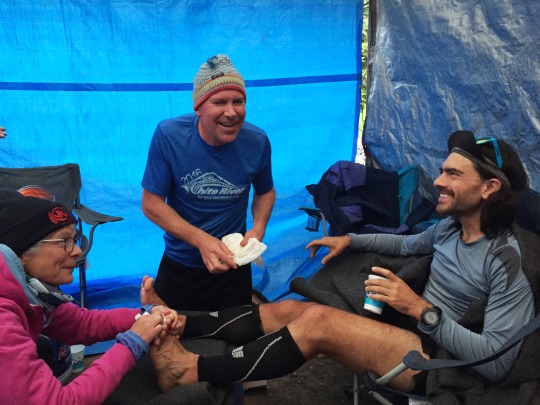
Masticated feet are hilarious! (Peter Dawson)
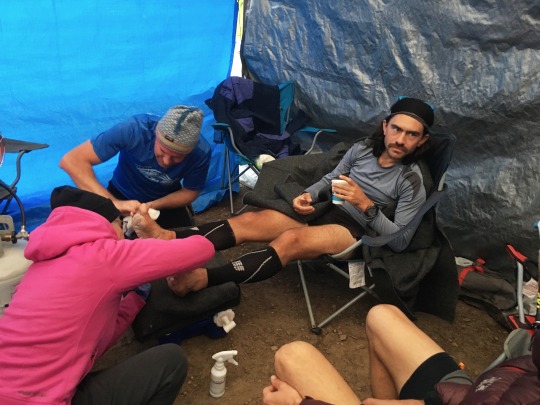
Not so funny anymore. Look at how white my feet are. (Erin Garnder Dawson)
We talk about my hypothermia, and Mark tells me that my body was probably just so worn out it couldn’t produce its own heat anymore. That was almost 20 hours ago at this point, but obviously I was still compromised. On top of that, my head cold is full blown now. Snot and other things are pouring out of me, and my voice fades in and out barely able to escape my throat. If John Mayer’s girlfriend’s body was a wonderland, mine is the opposite of that.
“I need to sleep,” I tell them. Somehow, this time, I’m pretty sure it won’t be a problem. Mark says they have a tent all set up for me with a cot. He and Peter help me up and lead me off into the dark. They deposit me into a small tent with a cot and sleeping bag waiting. “Here,” Mark says. “Wrap yourself around this.” He hands me a Nalgene full of hot water. “It’ll help bring your core temperature up.” I put it in the bag with me. It’s very warm. I’m instantly worried that I’m going to pee myself, but don’t think much past that.
“This is so cool,” I tell Mark and my crew who are staring down at me on the cot. They look inquisitively. “I’ve never been this messed up in a race before. Like, I’ve always seen people laying on cots and stuff. But now I’m actually getting to be one of them. It’s never happened before. This is so cool.” They laugh, knowing I’m insane. I probably am.
I tell them to get me up in 90 minutes. They leave. For a moment I worry that I’m not going to be able to fall asleep yet again.
Suddenly I slip into inky, warm blackness.
Resurrection
I sit up straight in bed. Time to run! I think excitedly. I look down at my watch. It’s been exactly 89 minutes since they left me in the tent. Just then, I hear a ziiiiip at the door. Peter pokes his head in. “Hey man, you alive?” “Yeah man,” I grin. “I’m alive.”
It’s turned dark outside. I hobble out of the tent, happy to have not peed myself. Back in the aid station tent, I feel like a totally new person. Mark the Medic checks my feet again, giving them a once-over. “Look at those things! Beautiful!” he exclaims. “Almost good as new!” I had to give it to him, they did almost look like they hadn’t spent the last 20 hours soaking in water.
Twenty-nine miles left. Easy-peasy. I gather my new gear, scarf another half a hamburger. During my downtime, I’ve managed to slip to tenth place. I’m just happy to be alive, so I take my sweet-ass time.
Finally, I’m ready. Peter’s ready. We wave a merry goodbye to everyone, and we’re off.
It’s a 2.7-mile trek back to the main Klickitat Trail, all uphill. I run it. I don’t just feel good. I feel great. Holy shit, I think. We cross paths with a few runners coming downhill to the aid, and I cheerily say hello. I even start to drop Peter a little. Maybe it’s because of my 180-mile warmup. Either way, we top out much more quickly than I expect.
Back up top, we fly down the trail, catching up about everything that’s transpired in the last 20 hours or so. The night is cool—not cold—and we soon feel pleasantly warm inside our clothes. After a few miles, we hit the short out and back to Pompey Peak. We climb the switchbacks up to the bald rock peak. Everywhere around us, we can sense the mountains and the tree, and we joke that it might be a lovely view. But in truth, it is. The sky is an explosion of stars above us. We linger a moment, savoring the rewards of our deep labor.
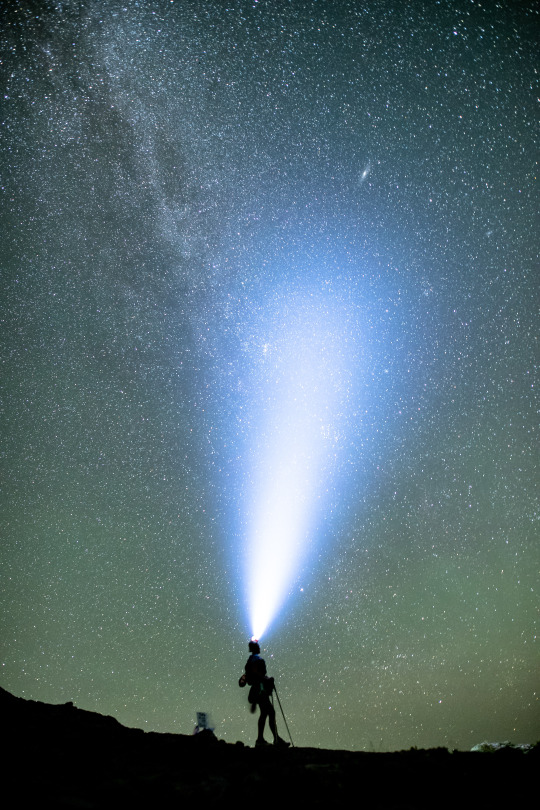
Another runner takes in the night sky on top of Pompey. (Scott Rokis)
“It’s all downhill from here,” I tell Peter as we drop off the top. And it’s true. The trail eventually turns downward, and we begin descending quickly. Just as I feel like maybe I’m home free, we come to a massive downed tree laying across the trail. I groan with annoyance, but in the grand scheme, it’s not so bad.
I detach my/Marc’s Leki poles, pull myself up and top, reattach the poles and then use them to hop down on the other side. We continue on. A minute later, we come to another tree. Argh. I do it again.
This time, when I clear the tree, I see another one just a dozen feet again. And then there’s another. And another. It’s an absolute mess out here. Fallen trees everywhere. Fallen trees that fell over more fallen trees. Each time, I have to detach my poles to free my hands to climb over. Each time, I grunt. Each time, it sucks more and more.
I don’t remember anything about this in the course description, I tell Peter. But here we are.
“I didn’t really expect to be doing fucking parkour at mile 185.”
Any happiness that I was riding before has been totally sucked out of me. I’m annoyed and miserable again. Then, I realize that I’m annoyed and miserable. I pull out of myself to see what’s happening. I remember my revelation from earlier. The moment you feel good out here, the race punches you in the face. No, I think. I’m not going to give in. I fight against the anger—not super convincingly—but I fight nonetheless. I don’t let it take hold.
It lasts for maybe a mile and a half. (It’s hard to have any objective understanding of distance at this point.) It’s awful. But I don’t give in to the anger. What’s the Yoda quote? “Fear leads to anger. Anger leads to hate. Hate leads to suffering.” Well, I was already suffering so no point in throwing the other three in, right?
Eventually, the trees thin out and the trail flattens. We emerge from the forest into… green. Just all green.
We’re in a green tunnel. Green grass underneath, overgrown green grass to our left and right, green trees beyond that. We’re on what appears to be an old road, now reclaimed by nature. There’s a slight downhill grade so we just roll with it. It’s nice to be getting easy miles in again. It’s also, just really… green. It’s all we can talk about. Our headlamps enhance the strange tunnel-ness of it all. I use it as fuel, ticking my speed upwards. Time to get this shit done.
The green tunnel seems to last forever. I’m running my face off. After a while, the monotony of the speed and vegetation creates mental drag. I occasionally stop to walk for a minute or two before picking the pace up again.
After an hour(?), we see something in the distance. Something manmade. It must be the aid station. As we near it, it gets smaller and smaller. Once we’re finally on it, I realize it’s a table stocked with bottles upon bottles of tequila. Gag. “Oh, this is the surprise that Candice promised out here.” I think back to the pre-race briefing where the RD hinted that she might have a surprise out here for us. For some reason, I figured it’d be someone in a bigfoot suit to scare us. I’m momentarily grateful because I don’t think I could handle that shit right now. Either way, there are a lot of nonsensical things about this sport, but ultrarunners’ fascination with taking a shot of tequila late in the race I will never understand. Needless to say, we do not partake.
On the upside, I assume this is a sign that the aid station is close. Ten more green minutes later, we round a bend, and the Owen’s Creek Aid Station (193.5 miles) comes into view. It’s all flood lights, heat lamps, and sizzling bacon. There’s also another—shall I say, “difficult”—runner already there. His family stands around him, trying to appease his whims. He snaps at them, complaining about stuff. I’m just happy that it looks like I’ll be moving up a place.
I want to get out there fast. I grab a plate of eggs and bacon—because, fuck it—and coffee—because, also fuck it. I finish half of everything and then declare it’s time to go.
The End
Thirteen miles to the finish. I check my watch again. It’s around 4:30 in the morning. All day my goals have been slipping. From CR to winning to sub-60 to just staying alive. But now with 7:00am on the horizon—meaning a 70-hour finish—I have a something to shoot for again. It’s going to be close though. I check my race plan, just 385 feet of elevation gain. Hell yeah.
Peter and I barrel down the gravel-and-rock road. It’s two miles to the paved road and the final leg of my journey. We make it to the road and turn left. Pavement. Civilization. Weird again.
As we pound the road, we can feel the earth starting to slowly awaken. Sunlight yawns and gently shakes the slumber from its eyes. Clouds of mist billow and rise from meadows next to us. Sleepy cows stare back at us, suspiciously. I feel alive myself.
The road is remote and desolate. There’s no shoulder whatsoever, so we find ourselves hugging the sides, hoping no one comes barreling around a curve. It’s Monday morning, after all, I think to myself. What will someone on their way to work think if they see my bag of bones shambling along the road? And then I think, Holy shit. Monday morning. People are going to work.
But I have a deadline to hit. I can smell the barn. I’m cranking. In fact, I start to pick up speed. I feel like I’m flying. I feel like I’m running faster than anyone’s ever run before. I’m in a full-out sprint.
Just then, I realize there are mile markers along the roadside. Great. I can see just how fast I’m going. I hit a mile marker and note the time. A few minutes later, I see the next one. I check my watch again. Well that can’t be right. Ten and a half minutes? I note the time again. The next mile marker comes. Eleven minutes?? I feel like I’m running faster than I’ve ever run in my life. Really, I’m running 11-minute miles. Cool.
All things considered, it’s still pretty fast. I guess.
And it was because a few minutes later, we come upon another figure gimping along ahead of us. He’s listing ever-so-slightly to his right side, as all ultrarunners like to do at the end of a race. And he’s alone. Ouch.
“Hey.” He greets us. “Hey. Are we on the right side of the river?” Oh boy.
“Yeah. This is right.”
“Oh, ‘cuz I thought we were supposed to be over on that side.” He points across to the opposite bank, far away, which has just disappeared from view in a jumble of forest.
“Well, that’s where we’re going. But we’re going to get up to another road and then turn to take a bridge over it.” I can’t believe I can recall all the details of the course three days in. Wish I had remembered something about all those downed trees…
Our friend is still confused, but at least he’s moving. So we bid him adieu and press on. Eighth place.
I like the number eight. That sounds good to me.
We pick our speed up again and start flying (relatively speaking). Eventually, the road passes a cluster of house, barns, and garages. More civilization. A good sign.
We turn onto a more major road. Another good sign. I can see the map in my head. I’m so close. So close. Holy shit I’m close.
At some point, Peter tells me he has to stop to take care of “some business” but tells me to keep going, and he’ll catch up.
Suddenly I’m alone again.
But it’s a good alone. Just me and the countryside. I pass more houses. Front yard set up in permanent yard sales. A sign for a farmer’s market. Tractors. A truck rumbles past.
Finally, I see a bridge. I know this bridge. I saw this bridge three days ago. I’m close.
I cross the bridge and the river below. I’m close.
A few hundred more feet, and I’m at an intersection. Of a highway. With gas stations and cars and stuff. More civilization. It’s all surreal.
I cross the highway and follow the flags onto a smaller backroad than curves to parallel the highway.
This is it. The home stretch. All alone, I think back over the last few days. How many has it been? What is today? I think back over everything that’s transpired. The moments of despair. The moments of elation. My crew. The mountains. The out-there-ness. The volcano. The forests. The hypothermia. The doubt. The quesadillas. (Oh, the quesadillas.) The shoes. The changes within myself. The miles. How many has it been?
I savor every step now. I will not be back here again soon.
There’s a gentle curve in the road, and the high school comes into view. A minute later, I find myself passing through its fence, into the parking lot. I see cars and trucks and piles of gear scattered everywhere and being sorted. It hit me how much goes into this. Not just my journey but everyone’s.
I follow a small sidewalk, through a short chain-link fence, and suddenly I’m on the track. It’s soft underfoot. Almost disarmingly so. It’s black. It has long white lines that I follow. I hear people cheer from the shanty town of awnings across the field, at the finish line. The finish line.
I take in everything. The pine trees. The brown, parched grass on the infield. The sky. The electrical wires. A pair of crows perched above. My mind floats inside my skull.
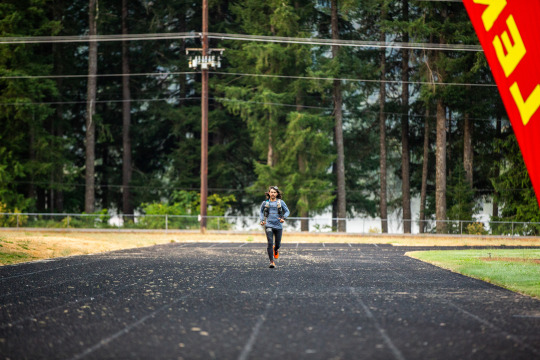
Smelling the bar, hard. (Scott Rokis)
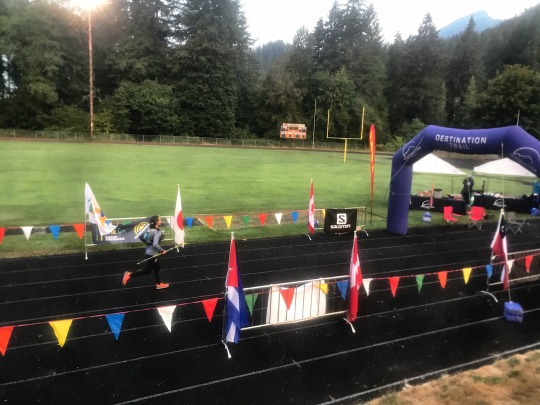
Moments away. (Marc Laveson)
I turn the final corner and look down the barrel of the finish, now populated with the screaming skeleton crew of a crowd.
There’s nothing left inside me except joy. Pure, vibrating joy. I’m swimming through it. My face already hurts from grinning.
And then, I’m done. I cross the finish line. It’s been 69 hours, 29 minutes, and 5 seconds. 206.5 miles—call it 208 with the sabotage. I’m done. It’s done.
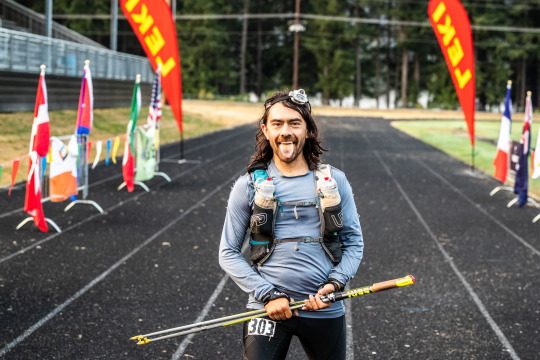
Done. (Scott Rokis)
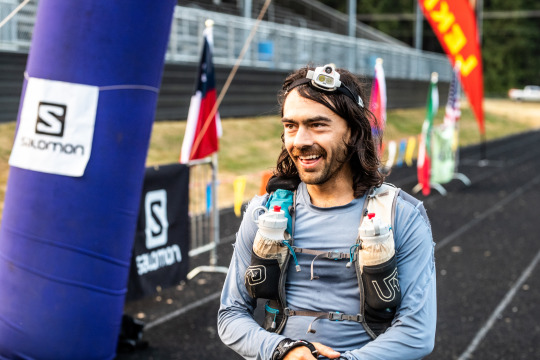
Like, really done. (Scott Rokis)
youtube
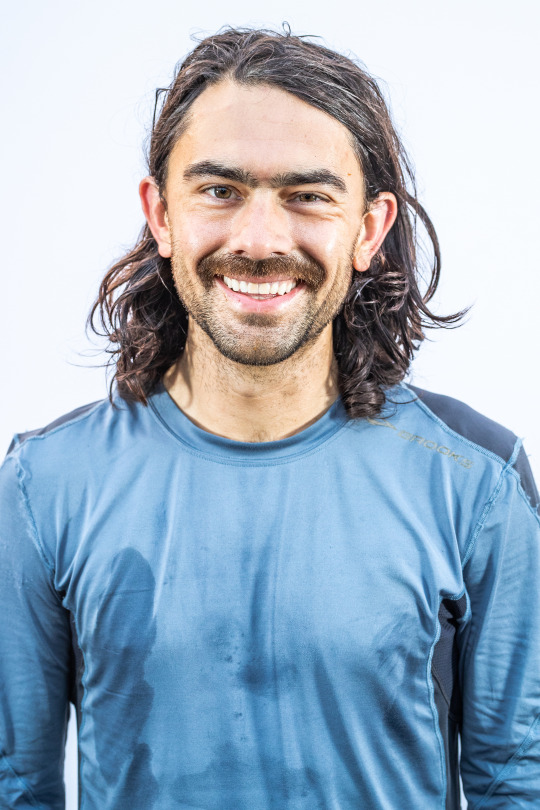
What running 208 miles feels like looks like. (Scott Rokis)
After The Party, It’s The After-Party
I lean over my poles as people swoop in to congratulate me. Candice is there. We exchange a few blurry impressions of the course. I tell her it’s the most beautiful course I’ve ever been on. Someone else asks if I want to eat anything. I never want to eat anything right after a race. I decline. “Maybe a grilled cheese?” she offers. “That sounds suspiciously like a quesadilla,” I shoot back. Everyone laughs. I laugh because I’ll never eat another quesadilla again in my entire life.
They sit me down in a camping chair and cover me with a blanket. I suddenly become acutely aware of how badly I stink.
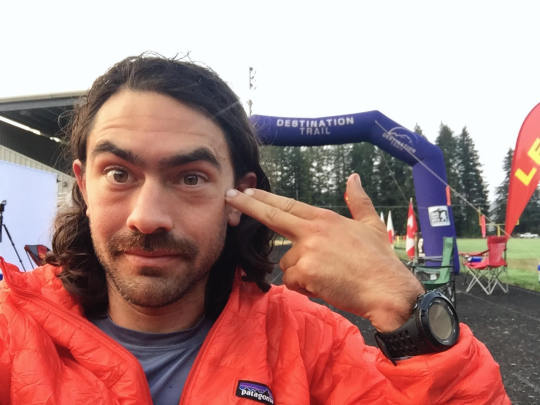
What the feeling of three days of running looks like.
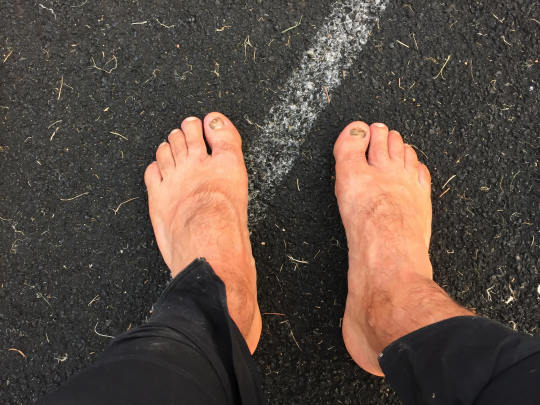
Fat feet. (Toenails previously removed.)
Our listing, confused road friend appears a short time later. After lingering at the finish line the requisite amount, I’m ready to get into a hotel room and shower. We pile into the massive Suburban. With the enclosed space, I once again become acutely aware of how badly I smell. I apologize to my crew. I’ve put them through enough already.
The sun is fully up now. It’s warm and aggressive. I’m standing in the parking lot of a hotel I booked months ago. I get in the room throw my bags down and slump into the shower. After 20 minutes(?)—time is meaningless—I get out, throw on clothes, and check my phone. There’s a message from Ethan Newberry on it. “Dude, congrats on the finish!!! Do you want to be on Ginger Runner Live tonight?” Sure, that sounds like an intense way to end this whole thing.
I exit my room out into the harshness of the late morning sun. I need food now. In cut-off shorts and flip-flops, I stagger down to the highway and follow it for a half mile until I come to Packwood, Washington’s finest—and also only—grocery store. Inside I proceed to buy the most insane things I can find. A platter of bright red colored Chinese pork of some sort. A bag of spicy pickles. Cheese sticks. A bag of cheese-flavored potato chips. A pint of cookie dough ice cream. A six pack of some local IPA. My only solace is that I’m probably not the strangest thing to blow through this roadside grocery store.
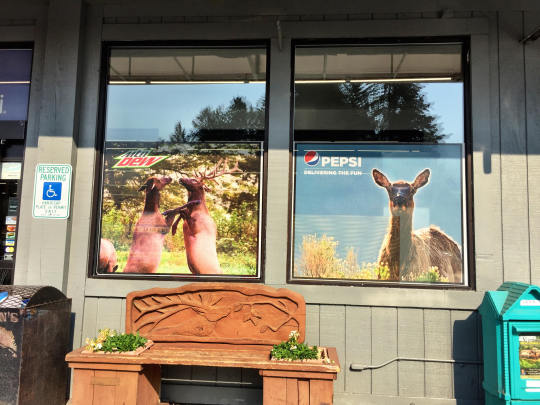
This is the kind of quality advertising the have in Packwood. A picture of elk fighting with a Mountain Dew logo over it and a picture of another elk with a Pepsi logo over it with the tagline “Delivering the fun.”
As I get to the register to check out, the cashier asks me how I’m doing. As I go to answer, I simply croak. A “…” Nothing comes out. A weak noise escapes my mouth, like a squeaking, frightened animal. I try again. Again, nothing comes out. I smile. She smiles back at me. It’s awkward.
The cold I’d been experiencing all race has finally fully manifested itself. Somehow between the stress of the miles and the illness, my vocal cords have packed up and gone home. I’m totally incapable of any sort of speech. I simply croak a “thanks” and retreat back to the hotel, where I proceed to feast and take a second bath again because, hey, I earned it.
The hotel after every 100-miler or more is always a blur. This is no exception. I knock back a beer and turn the Discovery Channel on. At some point, the Deadliest Catch lulls me to sleep.
I wake two hours later. The pain in my legs is all-consuming. I test my voice again. Nothing. I have to be on Ginger Runner Live in three hours. I brew some tea in the hotel coffee maker and add some lemon and honey that I’ve procured somewhere.
After two cups of tea, I venture out of my room. I hate sleeping.
It’s mid-afternoon now. I hobble down to the Blue Spruce Saloon. Anything called a saloon automatically has my vote. The enter and find a vast expanse of a place. But everyone is huddled around the curved bar at the front. Who patronizes the Blue Spruce Saloon in Packwood, Washington, at 3:00 in the afternoon on a Monday? Old people. RV types. Locals too. They’re all in there getting hammered off $3 Coors Lights. It’s fascinating.
I try to order a Stardust IPA—the most expensive and obviously douchiest—thing on the menu. The woman working the bar can’t understand a word I say. Mostly because I’m not really saying words. Just sounds. It’s instantly embarrassing again. I feel like the weirdo in a bar of retirees getting schlitzed at 3:00 in the afternoon. To be fair, I guess I am the weirdo who just ran 208 miles.
I enjoy my beer and the general feeling of not-running before hobbling back to the hotel.
At around 6:00 we start Ginger Runner Live. I’ve now slept a collective 3.5 hours in 3.5 days. Groovy.
youtube
I always love talking to Ethan and Kim, and it’s fun to be able to talk about the race with such fresh, raw emotions. At one point, Ethan turning to Kim and says, “I don’t think we’ve ever had someone on the show who just finished a race while the race was still going on.” It’s true. People are still out there running. God bless them. I’m not.
A few times, my voice goes out entirely and is replaced by what can only be described as a death rasp. At least it adds to the drama of the whole thing, I think.
But I make it through. After a really fun interview, I sign off. Now there is nothing left to do but let the sounds of the Discovery Channel lull me to sleep once more.
Now, I am finally, officially done.
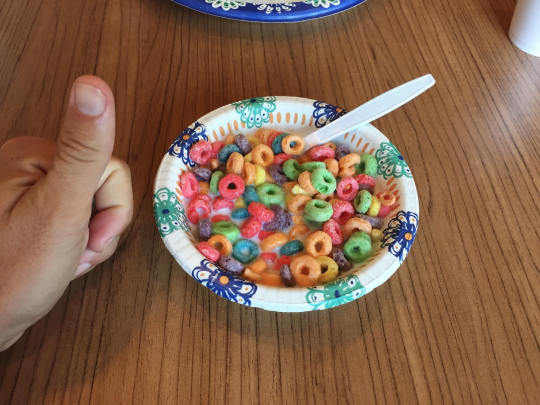
I ate so many bowls of free Fruit Loops at breakfast the next morning.
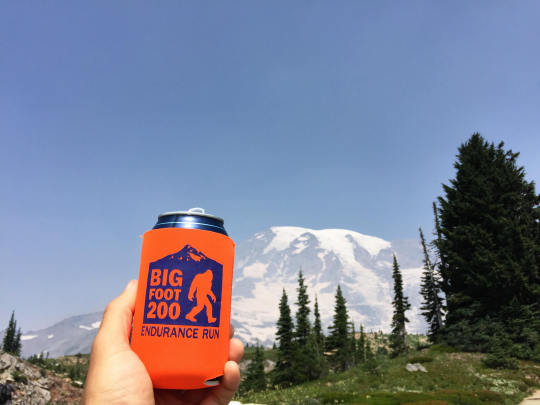
And I enjoyed a Bigfoot beer beneath Mt Rainer.
Looking Back
Running 200+ miles is, without a doubt, the hardest thing I’ve ever done. It broke me down. It made me dig deeper than I’ve ever had to. It asked everything of me.
I got exactly what I wanted out of it. It scared me. Not just “scared” me. It scared me on a deep, animal level.
When I finished I said I would never do that again. In fact, I said no human being should ever do that. It was dreadful.
But it was also unimaginable. Unimaginably beautiful. Unimaginably remote. Unimaginably brutal. Unimaginably whole.
I came closer to understanding own mortality and my own immortality in a single event. I came closer to touching the universe and everything in it.
The more time I have to reflect back on my experience, the more deeply affecting I realize it was.
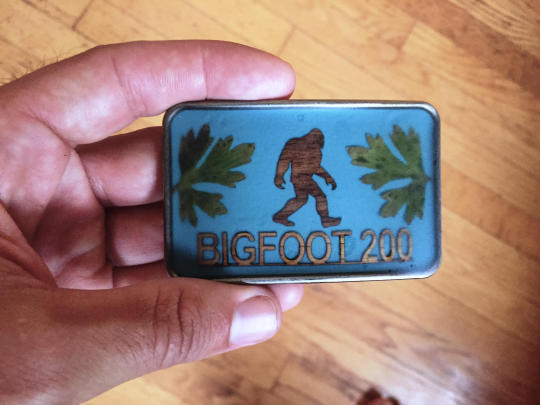
I believe.
8 notes
·
View notes
Text
Trump is ignoring his top health advisers over 2020 election fears
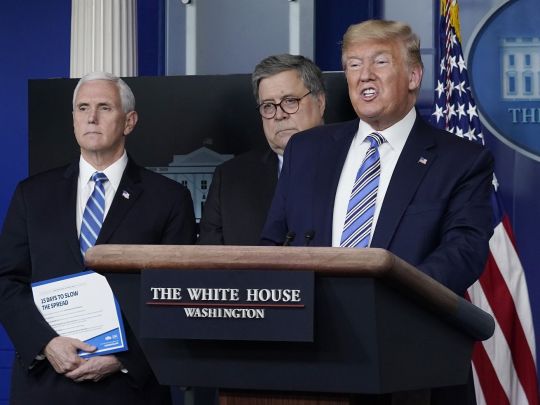
Trump speaks at the White House on Monday. | Photo by Drew Angerer/Getty Images
The US is halfway through Trump’s “15 days to slow the spread,” and he’s already pushing to end it — even with coronavirus cases on the rise.
On day seven of the White House’s “15 days to slow the spread” initiative, President Donald Trump started talking about sending Americans back to work — an idea at odds with advice from his top health advisers.
In a tweet on Sunday, the president said in all capital letters: “AT THE END OF THE 15 DAY PERIOD, WE WILL MAKE A DECISION AS TO WHICH WAY WE WANT TO GO!”
On Monday he retweeted similar opinions as news began to leak that behind the scenes Trump was sharing this view with his advisers, and one of his aides appeared on Fox News to say the same thing.
WE CANNOT LET THE CURE BE WORSE THAN THE PROBLEM ITSELF. AT THE END OF THE 15 DAY PERIOD, WE WILL MAKE A DECISION AS TO WHICH WAY WE WANT TO GO!
— Donald J. Trump (@realDonaldTrump) March 23, 2020
Trump’s eagerness to end social distancing was also a major topic of his marathon news conference on Monday evening. He said he plans to reopen certain parts of the economy “not long after” the 15-day initiative ends, even if his medical and public health advisers don’t agree with him.
“The doctors, if it was up to the doctors, they’d say ‘let’s shut down the entire world,’” Trump said at one point, adding at another that the shutdown “causes other problems, and maybe it causes much bigger problems than the problem we’re talking about now.”
.@kaitlancollins: Did any of the doctors on your team endorse easing the federal guidelines? TRUMP: "Not endorsed." pic.twitter.com/azN4bVbg2Z
— Aaron Rupar (@atrupar) March 23, 2020
The point of the 15-day initiative was to encourage social distancing to “slow the curve” of the virus and save lives. But as of Monday, there was no sign that the pandemic was slowing. In fact, outbreaks in America are even outpacing some of the worst-hit countries in the world.
Worse, most experts, like Dr. Anthony Fauci, Trump’s most-prominent expert on his coronavirus task force, warn that the pandemic will get worse before it gets better. Experts fear that talk of encouraging people to get back to their normal routines quickly could hamper efforts to slow the pandemic — or even encourage its spread.
Trump, however, indicated on Monday that he thinks people have already learned the necessary lessons — even though he was speaking on the day after single-day coronavirus-related deaths in the country broke 100 for the first time ever.
"We learned so much discipline" -- Trump is talking like the coronavirus pandemic is in the rear view mirror, when in fact America just broke 100 deaths in a single day for the first time. pic.twitter.com/pnmFzN1QxW
— Aaron Rupar (@atrupar) March 23, 2020
There is a minority opinion — one expressed in particular by economists associated with Trump — that resuming some economic activity after a 15-day period is a worthwhile risk to take. But even the most-aggressive argument emerging from that camp doesn’t compare to Trump’s willingness to send people back to work en masse. It’s clear that with the Dow plummeting and unemployment claims spiking, Trump fears an economic disaster ahead of the 2020 election could doom his prospects. (Trump even posted a retweet suggesting his idea is directly tied to the election.)
Trump’s sudden swing from calling for a 15-day day crackdown, to doubting the science it’s based on less than half-way through, is emblematic of his reckless approach to combating the coronavirus. All signs point to the crisis getting worse — and the man in charge is putting his own political interests before the lives of Americans.
Trump is getting frustrated with the advice of public health experts
On Monday, the president followed up on his previous night’s tweet by retweeting a number of accounts with sketchy handles like @steph93065 that urged him to get people back to work — not only for the sake of the economy, but for his reelection hopes as well.
“15 days. Then we isolate the high risk groups and the rest of us get back to work before it’s all over for everyone!! #Landslide2020,” wrote @FedupMil in a post that was retweeted by the president.
On Monday morning came a slew of news reports that Trump is “itching to scale back social distancing after 15-day period,” as CNN put it. The New York Times reported that “at the White House, in recent days, there has been a growing sentiment that medical experts were allowed to set policy that has hurt the economy, and there has been a push to find ways to let people start returning to work.”
Then came a Fox News appearance from top White House economics adviser Larry Kudlow in which Kudlow echoed points Trump made on Twitter.
“The president is right: The cure can’t be worse than the disease, and we’re gonna have to make some difficult trade-offs,” Kudlow said. “I spoke with the president about this very subject late last evening.”
KUDLOW teases that Trump will try to send people back to work next week: "We can't shut in the economy... POTUS is right: The cure can't be worse than the disease, & we're gonna have to make some difficult trade-offs... I spoke w/ POTUS about this very subject late last evening." pic.twitter.com/OV02aLFGxh
— Aaron Rupar (@atrupar) March 23, 2020
It’s understandable that the White House is eager to reestablish a sense of normalcy. Experts are now saying that the ongoing curtailment of economic life could produce unemployment levels worse than the Great Depression and an unprecedented shrinkage of GDP.
Trump would obviously have a hard time making a case for his reelection amid that sort of economic carnage. But to the extent he cares about American lives more than his own political future, the responsible thing to do is wait and see — at least until there’s some semblance of improvement, not as cases mount.
The number of US coronavirus cases continues to rise
The whole point of the 15-day program is to prevent the health care system from being overwhelmed by “flattening the curve” of coronavirus cases. But as the following chart indicates, the number of confirmed cases in the US continues to grow at an exponential rate.
//<![CDATA[ !function(){"use strict";window.addEventListener("message",function(a){if(void 0!==a.data["datawrapper-height"])for(var e in a.data["datawrapper-height"]){var t=document.getElementById("datawrapper-chart-"+e)||document.querySelector("iframe[src*='"+e+"']");t&&(t.style.height=a.data["datawrapper-height"][e]+"px")}});window.addEventListener('DOMContentLoaded',function(){var i=document.createElement("iframe");var e=document.getElementById("datawrapper-cbOrM");var t=e.dataset.iframeTitle||'Interactive graphic';i.setAttribute("src",e.dataset.iframe);i.setAttribute("title",t);i.setAttribute("frameborder","0");i.setAttribute("scrolling","no");i.setAttribute("aria-label",e.dataset.iframeFallbackAlt||t);i.setAttribute("title",t);i.setAttribute("height","400");i.setAttribute("id","datawrapper-chart-cbOrM");i.style.minWidth="100%";i.style.border="none";e.appendChild(i)})}() //]]>
There’s no indication that the number of cases will plateau or start coming down before next week. On the contrary, New York City Mayor Bill de Blasio said on Sunday that “it’s only getting worse, and in fact April and May are going to be a lot worse.”
It’s true that many of the US cases are concentrated in especially hard-hit regions like New York City, the San Francisco bay area, and Washington state. One might view that as contributing to an argument for the resumption of normal social and economic life in relatively better-off states like West Virginia or the Dakotas.
But the experience of Hong Kong, where the coronavirus seemed to be under control until a relaxation of social distancing resulted in a second outbreak and even more stringent measures, demonstrates the risk involved in prematurely encouraging people to go back to gyms, bars, and other places where the virus can spread. And the idea there’s much to be gained by reopening businesses in places like Grand Forks, North Dakota while San Francisco remains under lockdown and hospitals are at the verge of overflowing in New York is dubious at best.
Furthermore, while US coronavirus testing capacity has increased in recent days, the country still lags far behind others in terms of tests performed relative to the population — meaning we still don’t have a clear picture of how widely the virus has already spread.
Resuscitating the economy requires getting the virus under control
In the end, the choice Trump seems to think he faces between continuing strict social distancing measures meant at getting the coronavirus under control or ending them in hopes of stopping the economic collapse is a false one.
The latter can’t happen without the former, and the former can’t happen until the number of cases levels off, while more vigorous testing gives experts the tools they need to develop a better picture of how widely the virus has already spread.
Which is to say, even if you care about economic activity as the only value here, it's really not clear that anything like "business as usual" is even a possibility in the midst of a roaring pandemic, even if you let everything stay open.
— Chris Hayes (@chrislhayes) March 23, 2020
Marc Lipsitch, an epidemiology professor at the Harvard TH Chan School of Public Health and director of Harvard’s Center for Communicable Disease Dynamics, told the Washington Post that “every well-informed infectious epidemiologist I know of” thinks that the best way forward in the short term is more restriction, not less.
“We haven’t yet even seen signs that the growth [in coronavirus cases] is slowing, much less reversing. Now is the time to tighten restrictions on contacts that could transmit the virus, not loosen them,” Lipsitch said. “If we let up now we can be virtually certain that health care will be overwhelmed in many if not all parts of the country. This is the view of every well-informed infectious epidemiologist I know of.”
State governors have more authority than Trump to keep people at home, but what Trump says matters. For instance, the national standardization of social distancing measures throughout the country (with some notable exceptions, like beaches in Florida) came shortly after Trump stopped downplaying the gravity of the situation just over a week ago and embraced the “15 days” program.
At the very least, the president should wait until the outbreak is under control before trying to give people hope, because the trajectory of the numbers indicate there’s no good basis for doing so beyond short-term political self-interest. In fact, the quickest route back to some sense of normalcy is to stop the spread of the virus by continuing to encourage people to stay home, even if we have to do so for more than 15 days.
The news moves fast. To stay updated, follow Aaron Rupar on Twitter, and read more of Vox’s policy and politics coverage.
from Vox - All https://ift.tt/2wwy7Kh from Blogger https://ift.tt/2QCsKA0 via IFTTT
0 notes
Text
Golden Sun: Chapter 5 - Letters Home
Hey Guy’s, the fifth chapter for Golden Sun is now up. Here is a portion of it, you can find the rest of it on my Ao3 and Fanfiction .net account
Hope you enjoy!~
Thatch,
I do hope this letter finds you well in your current residence as I know how uneasy you must be by now. Oyaji, too, is beginning to have reservations about his assignment. He was convinced that by sending you, it would ease the mounting stress between our coven and that of the Count's but it appears that Oyaji is starting to second guess his decision.
This isn't to say that he does not have faith in your ability to complete your task, but simply that perhaps it was too soon for you to be there.
Nonetheless, we have faith in you. If you need backup let us know and we will send someone to help you as soon as we can.
I imagine you're rolling your eyes at our worry right about now. So I will not push the matter any further. Oyaji sends his love, as we all do. Your presence at the castle is very…noticeable. It's much less loud as you can imagine. But not as much as you would think, Blenheim recently returned to the castle after completing his latest travel. And while he was out he befriended an Oxen.
Can you believe that? He just strode into the castle with that creature in tow. And of course Fossa thought he was dinner and started chasing after the poor thing until Blenheim had to step in and reassure the animal that he wouldn't be turned into a meal. Oyaji was amuses as you might have guessed, while the staff was none too pleased at having to clean up the mess afterwards. So to appease them and as a way of apology I had to give them extra pay to get things back in order.
The kitchen staff also misses you you know, they claim their dishes aren't as great without you about the kitchen. And I have to say, I miss your cooking as well. No one brews coffee like you. But I'm afraid that's the only praise I'm willing to give in this letter lest your head, or should I say hair, get bigger than it already is.
With loving affection,
Marco Newgate
Hey Marco,
You do realize you don't have to be so formal in your letters right? We're buds, brothers even and here you are sending me this cordial shit like I'm the freaking Count. And that last note at the end, are you getting sentimental over me? I am so touched! I'm laughing by the way. Just like I did when I read the whole Ox encounter what's the name Blenheim gave him?
And yes! I did roll my eyes plenty of times, you and Oyaji don't have to worry about me, I'm fine for the most part. And really I wasn't planning on staying this long either, a month or two max and we're bordering on what now, three months?
(I sighed here)
Things certainly aren't easy. I have to admit it's tough here and I would rather be anywhere else than being confined to this castle and the Count; but...dare I think that fate had an ulterior motive to my being here?
Vamps here are warped Marc. The Count has it in his head that we as Vampires have to domineer over the humans and has begun collecting them as pets. He had servants before and I admit slaves here and there, but they weren't treated this badly before. The things that transpire in this castle are horrifying. We had thought Donquixote was bad in his weird fascination of capturing humans and making them act out his perverted fantasies, but that pales in comparison to this. Humans here are worth less than animals Marco, anything and everything they do is monitored and if they take a single step out of line they're beaten within an inch of their life. There seem to be different tiers to this madness as well. I have yet to see what gets done to those they dispose but I promise you it is not something I wish to find out. And…
I'm sorry I had to set the quill down, it's not easy writing this down especially with how infuriated it makes me. It's nothing short of hell for them Marco and no matter what I tell the stubborn old Count he just won't listen to reason. He doesn't see the humans outside as a threat, He believes that the castle walls will hold against an attack from them. And I tried to explain that the humans had clever ways to their methods, bombs, catapults you know the works… There is no getting across to him and I feel guilty Marc. This is my fault, all of this that is happening to the humans...to.
The humans are losing hope on having a better life. It's heartbreaking to see Marco. And I can't raise a single hand to help not without challenging the Count. But I want to help them. And that's the reason I'm still here. I'm going to find a way Marco, I promised someone here I would find a way.
How I wish I had your Inclination* right now, the ability to clearly analyze a situation and find the best possible solution. But instead I have this storytelling gift that can do nothing at all for them.
Some insight would be highly appreciated, and I miss you guys too.
With love and a great hairdo,
Thatch Newgate
#ThatchxIzo#IzoxThatch#opfanfic#opfanfiction#one piece#thatch#izou one piece#angst#angst fic#excerpt#leafy writes
2 notes
·
View notes
Text
Haley-Pence rivalry heats up as GOP weighs post-Trump future
New Post has been published on https://thebiafrastar.com/haley-pence-rivalry-heats-up-as-gop-weighs-post-trump-future/
Haley-Pence rivalry heats up as GOP weighs post-Trump future
Vice President Mike Pence and former U.N. Ambassador Nikki Haley have grabbed senior Republicans’ attention as fodder for a possible 2024 primary showdown. | Spencer Platt/Getty Images
politics
Interviews with top Republicans reveal they’re watching each other warily ahead of a potential 2024 showdown.
When top Republicans convened at the St. Regis resort in Aspen, Colo. last month for an exclusive donor retreat, several attendees said there was palpable tension in the room as the gathering’s two headliners prepared to speak: Vice President Mike Pence and former United Nations ambassador Nikki Haley.
The assembled group of governors, high-dollar donors, and operatives were well aware that the two have big ambitions; to some it seemed as if Pence and Haley, who spoke on back-to-back days, were vying for their attention. Some in the audience found themselves parsing and comparing the two speeches and buzzed they were getting a sneak preview of a 2024 Republican primary. Others recalled something peculiar: Neither Pence nor Haley acknowledged each other in their presentations, even though they gave shout-outs to others attending the retreat.
Story Continued Below
At a time when Republicans are starting to contemplate what their party will look like after Donald Trump leaves office, a rivalry has developed between the two politicians who cut markedly different profiles — and signs of strain are bubbling to the surface.
Pence and Haley aren’t openly sniping: Publicly, both sides maintain there’s nothing but mutual respect between them. But interviews with nearly two dozen top Republicans revealed that the opposing camps are closely tracking each other’s moves, and remain deeply suspicious of one another.
The Pence team has recently asked senior Republicans for updates on Haley’s outreach to donors. And with Haley embarking on a national fundraising tour and promoting a new outside political group, top Pence advisers blame her for persistent rumors that she will replace him on the Trump’s ticket in 2020. Tensions flared after Haley chose not to publicly repudiate a Wall Street Journal column in June urging Trump to put her on the ticket.
Earlier this month, Haley took a swipe at Trump after his criticism of Baltimore and its black congressman, Elijah Cummings. “This is so unnecessary,” she wrote on Twitter, adding the eyeroll emoji. White House counselor and former Pence pollster Kellyanne Conway then fired back: “THIS is so unnecessary. Trump-PENCE2020,” Conway wrote of Haley’s tweet.
The shadow fight shows no sign of abating. Pence has spent the year barnstorming swing states that will determine the outcome of the 2020 election. But on Monday, he will head to Haley’s home turf of South Carolina to give the keynote speech at an annual barbecue hosted by GOP Rep. Jeff Duncan that has previously attracted White House aspirants. South Carolina is a gimme for Trump in the 2020 general election, but it will be key to anyone seeking a future Republican presidential nomination.
“The two of them have absolutely been friends and worked well together over the years, but you have to suspend disbelief to say that their relationship going forward won’t be viewed within the context of the presidential election after next,” said Rob Godfrey, who served as a senior aide to Haley during her six-year tenure as South Carolina governor.
On Wednesday morning, POLITICO posed questions to a Haley spokesperson about her political activities, relationship with Pence, and interest in a future presidential bid. That afternoon, before her office provided a formal response to the inquiry, Haley took to Twitter to declare that she’d had “enough of the false rumors.”
“Vice President Pence has been a dear friend of mine for years. He has been a loyal and trustworthy VP to the President,” she added. “He has my complete support.”
The following morning, Haley spokeswoman Chaney Denton provided an explanation for the tweet.
“This foolish talk about the vice presidency has gone on for a long time. Ambassador Haley preferred to avoid it altogether,” Denton said. “It was only when the subject kept coming up over and over, including this week, that she decided it made sense to address it.”
While the two could hardly be more different — Pence is a 60-year-old social conservative, she is a 47-year-old daughter of Indian immigrants — those close to them say they have long had a warm relationship. Haley traveled to Indiana in 2012 to help Pence with his gubernatorial campaign, then returned three years later to headline a state GOP dinner while he was embroiled in a competitive reelection race.
The two also shared an adviser in Nick Ayers, a prominent consultant who spent four years as executive director of the Republican Governors Association. And their offices gave them access to the same pool of powerful donors who fund races for governor.
The recent divisions have been fueled partly by the rumors that Haley could replace Pence on the ticket and the fact she took so long to address them. Some top Pence aides said they think Haley or an ally was behind the Wall Street Journal op-ed, which a representative for the former ambassador denied.
The White House has pushed back against the idea that Pence will get booted. Trump privately told Pence he was irritated by the Wall Street Journal article, and last weekend the president told reporters he was “very happy” with the vice president and “wouldn’t be thinking about” removing him from the ticket.
Erick Erickson, a prominent conservative commentator who is close to Pence and Haley, said the former ambassador was wise to shoot down the VP speculation. The rumors had intensified so much that two governors had recently reached out to him to ask whether Pence was about to be canned, Erickson said.
“I do think there are people in Trump-world who question her loyalty now,” he said. “And so making sure they see her as loyal is a good thing and getting out there and defending the vice president about rumors that are circulating behind the scenes isn’t a bad thing for her to do.”
Pence’s inner circle is convinced Haley is laying the groundwork for a future presidential bid. Since departing the administration late last year, she’s crisscrossed the country raising money for down-ballot candidates and conservative groups. Haley has also formed “Stand for America,” a political advocacy organization.
The group allows Haley to cultivate major donors and establish the kind of national fundraising network she would need to mount a national campaign. Among those working for the group is Mark Harris, an operative who worked on a pro-Marco Rubio super PAC during the 2016 presidential campaign.
Some Haley skeptics said they’re watching to see whether she uses the organization to help candidates in next year’s races, or saves its resources for later. David McIntosh, the president of the anti-tax Club for Growth, said potential future Republican presidential candidates will be judged based on what they do to help the party in 2020.
“I know where Pence comes out on it, that’s exactly what he’s doing. I would hope — and Haley’s a smart politician so I think she would get it — that that’s her key task right now as well,” said McIntosh, a longtime Pence ally.
Denton, the Haley spokeswoman, said the former ambassador is “committed to helping get the Trump-Pence ticket reelected, and to helping Republicans hold the Senate majority and win back the House.”
“All of her political efforts this year are about the 2020 elections,” Denton added.
In a statement, Pence chief of staff Marc Short said, “The Vice President has enormous respect for Nikki Haley , and she was an excellent ambassador for the Trump-Pence agenda during her one year at the UN.” (Haley served as UN ambassador for just under two years.)
Further complicating the dynamic between Pence and Haley is the role of Ayers, who remains close to both. Senior Republicans want to see whether the 37-year-old operative, who stepped down as Pence’s chief of staff at the end of last year to return to his native Georgia, picks one over the other.
Former colleagues of Ayers, who has deep ties to the donor class, say he hasn’t chosen sides. He speaks with Pence and Haley regularly and was seen with both at the Aspen retreat, which was hosted by the RGA. A few weeks later, Ayers and Pence appeared together onstage before a national group of young conservative leaders.
The skirmish offers a potential preview of what’s in store for the GOP after 2020 — a fight over the direction of the party. Pence has been the president’s most unwavering ally since he joined the ticket in 2016, even when Trump’s policies and personal conduct veered far from the principles Pence had long been known for. Haley, who endorsed Marco Rubio in 2016 and was critical of Trump during the campaign, has shown a willingness to break from the administration. She has urged the GOP to be more inclusive, representing potentially a new direction for the party.
Haley’s forthcoming memoir, to be released in November, may offer a hint of her approach. While the book isn’t expected to take direct shots at the White House, its promotional materials describe her as “a leader who seeks to bring Americans together in divisive times.”
Read More
0 notes
Text
Barcelona 1-2 Chelsea: Frank Lampard’s side end tour of Japan on a high
Barcelona 1-2 Chelsea: Goals from Tammy Abraham and Ross Barkley provide the pre-season tour of Frank Lampard at the end of Japan at a high
Chelsea ended their pre -season tour of Japan with a 2-0 win over Barcelona
Tammy Abraham scored the first goal of the match after some excellent pressures
Ross Barkley then cam off the bank to make it 2-0 with a remote strike
Antoine Griezmann debuted after joining Atletico Madrid
Ivan Rakitic withdrew a goal for the Spanish giants with a lightning bolt
by Max Winters for Mailonline
published: 13:26 BST, July 23, 2019 [1 9459017] | Updated: 13:26 BST, July 23, 2019
Chelsea ended their pre-season tour of ] Japan in style with a victory over Barcelona in Saitama on Tuesday
It was the perfect way to bring their journey to Asia after they were last visited by Kawasaki Frontale defeated Frank Lampard optimism as the new season approaches
The Premier League side always looked comfortable against a Barcelona team without Luis Suarez and Lionel Messi and goals from Tammy Abraham and Ross Barkley made sure they won.
Chelsea ended their pre-season tour through Japan in a comfortable victory on Barcelona
Abraham latch in a loose ball and went around Marc-Andre have Stegen before he finished well
The striker jumped in the air trying to capture a starting role in the attack
Frank Lampard was impressed by what he saw from his team at the Saitama Stadium
G EVERY FACTS
Barcelona: Ter Stegen (Grandson 46), Pike (Todibo 46), Umtiti (Lenglet 46), Jordi Alba (Jaime 46), Roberto (Alena 46) , S. Busquets (Rakitic 46), Riqui Puig (De Jong 46), Collado (Malcolm 46), O. Busquets (Semedo 46), Dembele (Perez 46), Griezmann (Rafinha 46)
Subs not used: Feather, Araujo, Monchu.
Goals:
Bookings: None
Chelsea: Arrizabalaga, Azpilicueta (Bakayoko 70), Christensen (Tomori 46), Luiz ( Zouma 46), Emerson (Drinkon 70), Kovacic (Zappacosta 70)), Peter (Batshuayi 70), Mount (Barkley 60), Pulisic (Giroud 60), Abraham (Kenedy 60).
Caballero, Cumming, Palmer.
Objectives: Abraham 34, Barkley 81
Bookings: None
Antoine Griezmann, who makes his first start in a Barcelona shirt, looked lively in its appearance of 45 minutes.
He was a good match with Ousmane Dembele, but will no doubt look forward to forming a devastating trio with Messi and Suarez when competitive football starts.
The time for the game was far from that of a pointless pre-season game at the start.
Barca passed the ball at breakneck speed while the side of Lampard pushed his defense so high on the field that Marc-Andre Stegen hardly had an option to pass.
Abraham got the chance to prove his credentials for the regular No. 9 shirt and looked sharp for 60 minutes.
The 21-year-old wants to play a more prominent role after spending last season in Aston Villa and he first missed a glorious six-meter chance but reacted by leading his team.
The pressure from Chelsea was so stifling that they forced even the usually cool Sergio on the edge of his box.
Abraham first reacted to grab the loose ball, go past St Stegen and fire home in an empty net.
Antoine Griezmann made his first appearance for Barcelona since joining this month
Christian Pulisic was a threat on the left wing for Chelsea while he continued to adapt
Griezmann gives Chelsea & # 39; s Andreas Christensen in shrugs and tries to put him under pressure
Lampard barks instructions at his Chelsea players in the final game of their Japanese tour
] Griezmann needed medical help just before the rest after a blow to the leg
Barcelona made many changes during the break, while Frenkie de Jong entered midfield, while Chelsea made only a few defenses before sporadically changing the line-up during the second 45 minutes. With some neat play on the edge of the box, the ball was eventually rolled to the left, but Perez's shot went straight into the hands of Kepa Arrizabalaga.
Malcolm, one of those who fought in the Nou Camp for this future, then tried his luck from a distance, but his powerful left effort was also matched by an excellent dive, except Kepa.
Michy Batshuayi, another participant in the single striker, was given 20 minutes to impress and he missed a chance to double Chelsea's lead.
The Blues packed things up with about 10 minutes to play when Barkley collected a low pass from Marcos Alonso before squeezing a 20-meter strike in the nearby post. ]
Ivan Rakitic withdrew a goal late for the Spanish giants, but it turns out to be just a consolation, as Chelsea is now looking ahead to their remaining friends with the opening day of the season in Manchester United less than three weeks away.
Share or respond to this article:
Source link
0 notes
Text
The limits of endurance: A BMW R80 with Ducati flair
The Japanese custom scene continues to amaze us. Even though the internet shrinks the world, there are still gems in the East waiting to be discovered—often by word of mouth.
Switch Stance Riding is a small custom shop in Amakusa—a series of small, little-known islands off the coast of Kyushu, Japan’s most southwesterly island. This part of Japan is well off the beaten track but the photographer Marc Holstein recently paid a visit, and told us he was the only Westerner for miles.
Marc’s detective skills led him to builder Toshiyuki Kozaka, who specializes in European machinery—specifically, bevel-driven Ducatis. Toshiyuki he regularly transports himself and his bikes all the way to France, for the annual Wheels and Waves festival.
But Kozaka-san decided to take a break from his usual fare for this project, opting to work with a 1988-model BMW R80. “I wanted to show what it would look like if a Ducati builder laid his hands on a BMW,” he tells us.
The goal was to give the BMW a classic endurance racing vibe, along with a huge hit of 70s style. But Toshiyuki also wanted to combine the elegance of Italian parts with the underlying German engineering of the R80.
It’s an eclectic mash-up of ideas, but he’s pulled it off magnificently.
Up front, Toshiyuki grafted on the 40 mm forks and top yoke from an ultra-rare Ducati 750 F1 Montjuich. The rear was upgraded with an adjustable shock from Öhlins, complete with a remote reservoir. It’s hooked up to a Paralever swing arm and final drive—borrowed from a newer BMW.
The wheels are stunning 17” units from Speedline, one size smaller than the R80 originals, and wrapped in Pirelli Diablo Rosso II tires. The single-disc front brakes have been swapped out for a set of dual disc Brembos from a BMW K1100, with the calipers mounted on hand-made brackets.
For the bodywork, Toshiyuki matched up an aluminum Moto Guzzi race tank, with a NCR racing fairing originally designed for the Ducati Pantah. And although they come from two different sources, both parts fit like they were meant for each other.
The tank took some fettling to go on the BMW’s frame, but the fairing was an easier fit. There’s a 7” Koito headlight embedded up front.
The tail unit is completely custom, right down to the seat with its combination Alcantara and vinyl upholstery. Toshiyuki redesigned the subframe, and installed a CEV taillight and custom-made license plate bracket out back.
The cockpit has not been neglected. The clip-ons are also from the Ducati Montjuich, the grips are Yamaha TZ 250 items, and the speedo is from Motogadget, mounted on a custom bracket.
A pair of modern sport bike mirrors carry the front turn signals, and a set of unbranded off-the-shelf rearsets rounds out the controls.
Toshiyuki left the motor itself stock, and with its airbox intact. A performance boost comes from a pair of Keihin FCR39 flatslide carbs, replacing the stock Bings, and a two-into-one exhaust system with an incredibly loud race silencer.
The wiring’s been tweaked with Dyna coils, Nology plug wires and a lighter Lithium-ion battery. There are neat little touches all over—like the carbon front fender, and the chunky, drilled exhaust hanger.
For paint, Toshiyuki had the bike finished in a pearl white, and the frame in blue. His close friend Orvis One, over in nearby Kumamato, then pushed the R80 over the finish line with an inspired throwback livery—all done by hand.
It’s a most unlikely concept, blending BMW and Ducati components, but the graphics, the parts spec and the classic endurance vibe has got us smitten.
We’re curious to see what Switch Stance will produce next—and wondering what other hidden gems are waiting to be discovered amongst the back roads of Japan.
Switch Stance Riding | Facebook | Instagram | Images by, and with thanks to, Marc Holstein
0 notes
Text
Trump narrows Supreme Court list, to name nominee July 9
ABOARD AIR FORCE ONE (Reuters) – U.S. President Donald Trump said on Friday he plans to announce his nominee to replace retiring U.S. Supreme Court Justice Anthony Kennedy on July 9, and that he has narrowed his list of candidates.
“I’ve got it down to about five,” Trump said, including two women.
He would not identify the candidates by name. “It’s a great group of intellectual talent … they are generally conservative,” Trump said.
When asked about several specific potential nominees mentioned in recent days, including federal jurists Brett M. Kavanaugh and Amy Coney Barrett, and U.S. Senator Mike Lee from Utah, Trump said each was “outstanding.”
Speaking to reporters aboard Air Force One en route from Washington to his private golf club in New Jersey, Trump said he may interview two contenders for the nomination this weekend.
Trump said he not will push the candidates to say whether they would overturn the 1973 Roe v. Wade decision, which established a woman’s right to abortion.
“That’s not a question I’ll be asking,” he said.
He also said he would not discuss gay rights with the candidates, and that he might interview as many as seven people.
While Kennedy was a conservative, he proved to be a somewhat unpredictable “swing” vote over his long career. For example, he sided with the court’s liberals by voting in favor of abortion rights and gay rights in key cases. Views on abortion was expected to be one that senators will ask the new nominee about in confirmation hearings, even if the president does not.
Trump’s nominee must win confirmation by the Senate. Republicans control the chamber but only by a slim majority, making the views of moderates, including some Democrats, important.
Senate Republican leader Mitch McConnell said on Friday he hoped the confirmation process would be done “in time for the new justice to begin the fall term of the Supreme Court … the first Monday in October.”
White House aide Marc Short said on MSNBC that the White House hoped for a Senate confirmation vote in September.
That would put a new justice in place before the congressional midterm elections in November, when all seats in the House of Representatives and a third of those in the Senate will be contested.
Trump met on Thursday with senators from both parties at the White House to discuss the court vacancy created by the retirement of Kennedy, which was announced on Wednesday.
Kennedy’s replacement could cast a deciding vote on limiting or ending the right to abortion.
“I do not apply ideological litmus tests to nominees, but I want to see integrity, intellect, a respect for precedent and adherence to the rule of law,” moderate Republican Senator Susan Collins told Reuters when asked about Roe v. Wade.
Collins, who favors a woman’s right to choose on abortion, joined like-minded Republican Lisa Murkowski at the White House meeting. Also attending were Republican Charles Grassley and Democrats Joe Manchin, Joe Donnelly and Heidi Heitkamp.
Democrat Bill Nelson, asked by reporters if a nominee’s views on Roe v. Wade will be important to him, said, “very.”
U.S. President Donald Trump waves as he walks on the South Lawn of the White House upon his return from Mount Pleasant, Wisconsin, to Washington, U.S., June 28, 2018. REUTERS/Yuri Gripas
Additional reporting by Steve Holland and Makini Brice; Editing by Kevin Drawbaugh, Cynthia Osterman and Bill Berkrot
The post Trump narrows Supreme Court list, to name nominee July 9 appeared first on World The News.
from World The News https://ift.tt/2tS0Ofl via Online News
#World News#Today News#Daily News#Breaking News#News Headline#Entertainment News#Sports news#Sci-Tech
0 notes
Link

Trump speaks at the White House on Monday. | Photo by Drew Angerer/Getty Images
The US is halfway through Trump’s “15 days to slow the spread,” and he’s already pushing to end it — even with coronavirus cases on the rise.
On day seven of the White House’s “15 days to slow the spread” initiative, President Donald Trump started talking about sending Americans back to work — an idea at odds with advice from his top health advisers.
In a tweet on Sunday, the president said in all capital letters: “AT THE END OF THE 15 DAY PERIOD, WE WILL MAKE A DECISION AS TO WHICH WAY WE WANT TO GO!”
On Monday he retweeted similar opinions as news began to leak that behind the scenes Trump was sharing this view with his advisers, and one of his aides appeared on Fox News to say the same thing.
WE CANNOT LET THE CURE BE WORSE THAN THE PROBLEM ITSELF. AT THE END OF THE 15 DAY PERIOD, WE WILL MAKE A DECISION AS TO WHICH WAY WE WANT TO GO!
— Donald J. Trump (@realDonaldTrump) March 23, 2020
Trump’s eagerness to end social distancing was also a major topic of his marathon news conference on Monday evening. He said he plans to reopen certain parts of the economy “not long after” the 15-day initiative ends, even if his medical and public health advisers don’t agree with him.
“The doctors, if it was up to the doctors, they’d say ‘let’s shut down the entire world,’” Trump said at one point, adding at another that the shutdown “causes other problems, and maybe it causes much bigger problems than the problem we’re talking about now.”
.@kaitlancollins: Did any of the doctors on your team endorse easing the federal guidelines? TRUMP: "Not endorsed." pic.twitter.com/azN4bVbg2Z
— Aaron Rupar (@atrupar) March 23, 2020
The point of the 15-day initiative was to encourage social distancing to “slow the curve” of the virus and save lives. But as of Monday, there was no sign that the pandemic was slowing. In fact, outbreaks in America are even outpacing some of the worst-hit countries in the world.
Worse, most experts, like Dr. Anthony Fauci, Trump’s most-prominent expert on his coronavirus task force, warn that the pandemic will get worse before it gets better. Experts fear that talk of encouraging people to get back to their normal routines quickly could hamper efforts to slow the pandemic — or even encourage its spread.
Trump, however, indicated on Monday that he thinks people have already learned the necessary lessons — even though he was speaking on the day after single-day coronavirus-related deaths in the country broke 100 for the first time ever.
"We learned so much discipline" -- Trump is talking like the coronavirus pandemic is in the rear view mirror, when in fact America just broke 100 deaths in a single day for the first time. pic.twitter.com/pnmFzN1QxW
— Aaron Rupar (@atrupar) March 23, 2020
There is a minority opinion — one expressed in particular by economists associated with Trump — that resuming some economic activity after a 15-day period is a worthwhile risk to take. But even the most-aggressive argument emerging from that camp doesn’t compare to Trump’s willingness to send people back to work en masse. It’s clear that with the Dow plummeting and unemployment claims spiking, Trump fears an economic disaster ahead of the 2020 election could doom his prospects. (Trump even posted a retweet suggesting his idea is directly tied to the election.)
Trump’s sudden swing from calling for a 15-day day crackdown, to doubting the science it’s based on less than half-way through, is emblematic of his reckless approach to combating the coronavirus. All signs point to the crisis getting worse — and the man in charge is putting his own political interests before the lives of Americans.
Trump is getting frustrated with the advice of public health experts
On Monday, the president followed up on his previous night’s tweet by retweeting a number of accounts with sketchy handles like @steph93065 that urged him to get people back to work — not only for the sake of the economy, but for his reelection hopes as well.
“15 days. Then we isolate the high risk groups and the rest of us get back to work before it’s all over for everyone!! #Landslide2020,” wrote @FedupMil in a post that was retweeted by the president.
On Monday morning came a slew of news reports that Trump is “itching to scale back social distancing after 15-day period,” as CNN put it. The New York Times reported that “at the White House, in recent days, there has been a growing sentiment that medical experts were allowed to set policy that has hurt the economy, and there has been a push to find ways to let people start returning to work.”
Then came a Fox News appearance from top White House economics adviser Larry Kudlow in which Kudlow echoed points Trump made on Twitter.
“The president is right: The cure can’t be worse than the disease, and we’re gonna have to make some difficult trade-offs,” Kudlow said. “I spoke with the president about this very subject late last evening.”
KUDLOW teases that Trump will try to send people back to work next week: "We can't shut in the economy... POTUS is right: The cure can't be worse than the disease, & we're gonna have to make some difficult trade-offs... I spoke w/ POTUS about this very subject late last evening." pic.twitter.com/OV02aLFGxh
— Aaron Rupar (@atrupar) March 23, 2020
It’s understandable that the White House is eager to reestablish a sense of normalcy. Experts are now saying that the ongoing curtailment of economic life could produce unemployment levels worse than the Great Depression and an unprecedented shrinkage of GDP.
Trump would obviously have a hard time making a case for his reelection amid that sort of economic carnage. But to the extent he cares about American lives more than his own political future, the responsible thing to do is wait and see — at least until there’s some semblance of improvement, not as cases mount.
The number of US coronavirus cases continues to rise
The whole point of the 15-day program is to prevent the health care system from being overwhelmed by “flattening the curve” of coronavirus cases. But as the following chart indicates, the number of confirmed cases in the US continues to grow at an exponential rate.
//
There’s no indication that the number of cases will plateau or start coming down before next week. On the contrary, New York City Mayor Bill de Blasio said on Sunday that “it’s only getting worse, and in fact April and May are going to be a lot worse.”
It’s true that many of the US cases are concentrated in especially hard-hit regions like New York City, the San Francisco bay area, and Washington state. One might view that as contributing to an argument for the resumption of normal social and economic life in relatively better-off states like West Virginia or the Dakotas.
But the experience of Hong Kong, where the coronavirus seemed to be under control until a relaxation of social distancing resulted in a second outbreak and even more stringent measures, demonstrates the risk involved in prematurely encouraging people to go back to gyms, bars, and other places where the virus can spread. And the idea there’s much to be gained by reopening businesses in places like Grand Forks, North Dakota while San Francisco remains under lockdown and hospitals are at the verge of overflowing in New York is dubious at best.
Furthermore, while US coronavirus testing capacity has increased in recent days, the country still lags far behind others in terms of tests performed relative to the population — meaning we still don’t have a clear picture of how widely the virus has already spread.
Resuscitating the economy requires getting the virus under control
In the end, the choice Trump seems to think he faces between continuing strict social distancing measures meant at getting the coronavirus under control or ending them in hopes of stopping the economic collapse is a false one.
The latter can’t happen without the former, and the former can’t happen until the number of cases levels off, while more vigorous testing gives experts the tools they need to develop a better picture of how widely the virus has already spread.
Which is to say, even if you care about economic activity as the only value here, it's really not clear that anything like "business as usual" is even a possibility in the midst of a roaring pandemic, even if you let everything stay open.
— Chris Hayes (@chrislhayes) March 23, 2020
Marc Lipsitch, an epidemiology professor at the Harvard TH Chan School of Public Health and director of Harvard’s Center for Communicable Disease Dynamics, told the Washington Post that “every well-informed infectious epidemiologist I know of” thinks that the best way forward in the short term is more restriction, not less.
“We haven’t yet even seen signs that the growth [in coronavirus cases] is slowing, much less reversing. Now is the time to tighten restrictions on contacts that could transmit the virus, not loosen them,” Lipsitch said. “If we let up now we can be virtually certain that health care will be overwhelmed in many if not all parts of the country. This is the view of every well-informed infectious epidemiologist I know of.”
State governors have more authority than Trump to keep people at home, but what Trump says matters. For instance, the national standardization of social distancing measures throughout the country (with some notable exceptions, like beaches in Florida) came shortly after Trump stopped downplaying the gravity of the situation just over a week ago and embraced the “15 days” program.
At the very least, the president should wait until the outbreak is under control before trying to give people hope, because the trajectory of the numbers indicate there’s no good basis for doing so beyond short-term political self-interest. In fact, the quickest route back to some sense of normalcy is to stop the spread of the virus by continuing to encourage people to stay home, even if we have to do so for more than 15 days.
The news moves fast. To stay updated, follow Aaron Rupar on Twitter, and read more of Vox’s policy and politics coverage.
from Vox - All https://ift.tt/2wwy7Kh
0 notes
Text
Trump narrows Supreme Court list, to name nominee July 9
ABOARD AIR FORCE ONE (Reuters) – U.S. President Donald Trump said on Friday he plans to announce his nominee to replace retiring U.S. Supreme Court Justice Anthony Kennedy on July 9, and that he has narrowed his list of candidates.
“I’ve got it down to about five,” Trump said, including two women.
He would not identify the candidates by name. “It’s a great group of intellectual talent … they are generally conservative,” Trump said.
When asked about several specific potential nominees mentioned in recent days, including federal jurists Brett M. Kavanaugh and Amy Coney Barrett, and U.S. Senator Mike Lee from Utah, Trump said each was “outstanding.”
Speaking to reporters aboard Air Force One en route from Washington to his private golf club in New Jersey, Trump said he may interview two contenders for the nomination this weekend.
Trump said he not will push the candidates to say whether they would overturn the 1973 Roe v. Wade decision, which established a woman’s right to abortion.
“That’s not a question I’ll be asking,” he said.
He also said he would not discuss gay rights with the candidates, and that he might interview as many as seven people.
While Kennedy was a conservative, he proved to be a somewhat unpredictable “swing” vote over his long career. For example, he sided with the court’s liberals by voting in favor of abortion rights and gay rights in key cases. Views on abortion was expected to be one that senators will ask the new nominee about in confirmation hearings, even if the president does not.
Trump’s nominee must win confirmation by the Senate. Republicans control the chamber but only by a slim majority, making the views of moderates, including some Democrats, important.
Senate Republican leader Mitch McConnell said on Friday he hoped the confirmation process would be done “in time for the new justice to begin the fall term of the Supreme Court … the first Monday in October.”
White House aide Marc Short said on MSNBC that the White House hoped for a Senate confirmation vote in September.
That would put a new justice in place before the congressional midterm elections in November, when all seats in the House of Representatives and a third of those in the Senate will be contested.
Trump met on Thursday with senators from both parties at the White House to discuss the court vacancy created by the retirement of Kennedy, which was announced on Wednesday.
Kennedy’s replacement could cast a deciding vote on limiting or ending the right to abortion.
“I do not apply ideological litmus tests to nominees, but I want to see integrity, intellect, a respect for precedent and adherence to the rule of law,” moderate Republican Senator Susan Collins told Reuters when asked about Roe v. Wade.
Collins, who favors a woman’s right to choose on abortion, joined like-minded Republican Lisa Murkowski at the White House meeting. Also attending were Republican Charles Grassley and Democrats Joe Manchin, Joe Donnelly and Heidi Heitkamp.
Democrat Bill Nelson, asked by reporters if a nominee’s views on Roe v. Wade will be important to him, said, “very.”
U.S. President Donald Trump waves as he walks on the South Lawn of the White House upon his return from Mount Pleasant, Wisconsin, to Washington, U.S., June 28, 2018. REUTERS/Yuri Gripas
Additional reporting by Steve Holland and Makini Brice; Editing by Kevin Drawbaugh, Cynthia Osterman and Bill Berkrot
The post Trump narrows Supreme Court list, to name nominee July 9 appeared first on World The News.
from World The News https://ift.tt/2tS0Ofl via News of World
0 notes
Text
Trump narrows Supreme Court list, to name nominee July 9
ABOARD AIR FORCE ONE (Reuters) – U.S. President Donald Trump said on Friday he plans to announce his nominee to replace retiring U.S. Supreme Court Justice Anthony Kennedy on July 9, and that he has narrowed his list of candidates.
“I’ve got it down to about five,” Trump said, including two women.
He would not identify the candidates by name. “It’s a great group of intellectual talent … they are generally conservative,” Trump said.
When asked about several specific potential nominees mentioned in recent days, including federal jurists Brett M. Kavanaugh and Amy Coney Barrett, and U.S. Senator Mike Lee from Utah, Trump said each was “outstanding.”
Speaking to reporters aboard Air Force One en route from Washington to his private golf club in New Jersey, Trump said he may interview two contenders for the nomination this weekend.
Trump said he not will push the candidates to say whether they would overturn the 1973 Roe v. Wade decision, which established a woman’s right to abortion.
“That’s not a question I’ll be asking,” he said.
He also said he would not discuss gay rights with the candidates, and that he might interview as many as seven people.
While Kennedy was a conservative, he proved to be a somewhat unpredictable “swing” vote over his long career. For example, he sided with the court’s liberals by voting in favor of abortion rights and gay rights in key cases. Views on abortion was expected to be one that senators will ask the new nominee about in confirmation hearings, even if the president does not.
Trump’s nominee must win confirmation by the Senate. Republicans control the chamber but only by a slim majority, making the views of moderates, including some Democrats, important.
Senate Republican leader Mitch McConnell said on Friday he hoped the confirmation process would be done “in time for the new justice to begin the fall term of the Supreme Court … the first Monday in October.”
White House aide Marc Short said on MSNBC that the White House hoped for a Senate confirmation vote in September.
That would put a new justice in place before the congressional midterm elections in November, when all seats in the House of Representatives and a third of those in the Senate will be contested.
Trump met on Thursday with senators from both parties at the White House to discuss the court vacancy created by the retirement of Kennedy, which was announced on Wednesday.
Kennedy’s replacement could cast a deciding vote on limiting or ending the right to abortion.
“I do not apply ideological litmus tests to nominees, but I want to see integrity, intellect, a respect for precedent and adherence to the rule of law,” moderate Republican Senator Susan Collins told Reuters when asked about Roe v. Wade.
Collins, who favors a woman’s right to choose on abortion, joined like-minded Republican Lisa Murkowski at the White House meeting. Also attending were Republican Charles Grassley and Democrats Joe Manchin, Joe Donnelly and Heidi Heitkamp.
Democrat Bill Nelson, asked by reporters if a nominee’s views on Roe v. Wade will be important to him, said, “very.”
U.S. President Donald Trump waves as he walks on the South Lawn of the White House upon his return from Mount Pleasant, Wisconsin, to Washington, U.S., June 28, 2018. REUTERS/Yuri Gripas
Additional reporting by Steve Holland and Makini Brice; Editing by Kevin Drawbaugh, Cynthia Osterman and Bill Berkrot
The post Trump narrows Supreme Court list, to name nominee July 9 appeared first on World The News.
from World The News https://ift.tt/2tS0Ofl via Everyday News
0 notes
Text
Trump narrows Supreme Court list, to name nominee July 9
ABOARD AIR FORCE ONE (Reuters) – U.S. President Donald Trump said on Friday he plans to announce his nominee to replace retiring U.S. Supreme Court Justice Anthony Kennedy on July 9, and that he has narrowed his list of candidates.
“I’ve got it down to about five,” Trump said, including two women.
He would not identify the candidates by name. “It’s a great group of intellectual talent … they are generally conservative,” Trump said.
When asked about several specific potential nominees mentioned in recent days, including federal jurists Brett M. Kavanaugh and Amy Coney Barrett, and U.S. Senator Mike Lee from Utah, Trump said each was “outstanding.”
Speaking to reporters aboard Air Force One en route from Washington to his private golf club in New Jersey, Trump said he may interview two contenders for the nomination this weekend.
Trump said he not will push the candidates to say whether they would overturn the 1973 Roe v. Wade decision, which established a woman’s right to abortion.
“That’s not a question I’ll be asking,” he said.
He also said he would not discuss gay rights with the candidates, and that he might interview as many as seven people.
While Kennedy was a conservative, he proved to be a somewhat unpredictable “swing” vote over his long career. For example, he sided with the court’s liberals by voting in favor of abortion rights and gay rights in key cases. Views on abortion was expected to be one that senators will ask the new nominee about in confirmation hearings, even if the president does not.
Trump’s nominee must win confirmation by the Senate. Republicans control the chamber but only by a slim majority, making the views of moderates, including some Democrats, important.
Senate Republican leader Mitch McConnell said on Friday he hoped the confirmation process would be done “in time for the new justice to begin the fall term of the Supreme Court … the first Monday in October.”
White House aide Marc Short said on MSNBC that the White House hoped for a Senate confirmation vote in September.
That would put a new justice in place before the congressional midterm elections in November, when all seats in the House of Representatives and a third of those in the Senate will be contested.
Trump met on Thursday with senators from both parties at the White House to discuss the court vacancy created by the retirement of Kennedy, which was announced on Wednesday.
Kennedy’s replacement could cast a deciding vote on limiting or ending the right to abortion.
“I do not apply ideological litmus tests to nominees, but I want to see integrity, intellect, a respect for precedent and adherence to the rule of law,” moderate Republican Senator Susan Collins told Reuters when asked about Roe v. Wade.
Collins, who favors a woman’s right to choose on abortion, joined like-minded Republican Lisa Murkowski at the White House meeting. Also attending were Republican Charles Grassley and Democrats Joe Manchin, Joe Donnelly and Heidi Heitkamp.
Democrat Bill Nelson, asked by reporters if a nominee’s views on Roe v. Wade will be important to him, said, “very.”
U.S. President Donald Trump waves as he walks on the South Lawn of the White House upon his return from Mount Pleasant, Wisconsin, to Washington, U.S., June 28, 2018. REUTERS/Yuri Gripas
Additional reporting by Steve Holland and Makini Brice; Editing by Kevin Drawbaugh, Cynthia Osterman and Bill Berkrot
The post Trump narrows Supreme Court list, to name nominee July 9 appeared first on World The News.
from World The News https://ift.tt/2tS0Ofl via Breaking News
0 notes
Text
Laureus World Sports Awards Declares for Greatest Sporting Moment of the Year
It forced the match to be postponed and also several of the travelling lovers, after the Borussia Dortmund team bus had been struck by an explosion before the Champions League quarter-final with Monaco on 11 April. That is when the German club supporters did something unheard of: they chose to social media to provide their homes to their “rivals”.
Just as heartwarming is the narrative of Bill Conner — that cycled over 2,000 kilometers to honour his deceased daughter Abbey and her organ donation — and Billy ‘The Whizz’ Monger — a 18-year-old Formula 4 motorist, who suffered life-changing injury but didn’t allow it to hold him back.
September’s six contenders for Laureus’ Greatest Sporting Moment, which include India’s Man Kaur (fourth from right), who is a 101-year-old athlete who also won gold at the World Masters Games.
There’s also the inspiring story of a athlete Man Kaur, who sprinted to gold .
From hard age the six contenders to the Laureus Greatest Sporting Moment of the Year of this month are not just inspiring, but heartwarming and emotional to say the very least.
From August to December, the public can pick their favorite from a shortlist of six videos, selected by the sporting legends of the Laureus World Sports Academy every month. The five monthly winners will then proceed head-to-head for a general vote, with the winner being announced at the 2018 Laureus Awards Ceremony.
Laureus Greatest Sporting Moments demonstrate qualities like sportsmanship, drama, fair play, and devotion, and look beyond the scoreboard or podium. They symbolise the actual values of sport and contribute to life the message that sport has the capacity.
Since Laureus World Sports Awards’ India spouses, Firstpost brings one of the September nominees for its 2018 edition:
For Person Kaur, from Chandigarh in India, age is just a number. The Masters athlete picked up the gold medal of her career on 24 April at the World Masters Games in Auckland, New Zealand, finishing the dash in 1 minute and 14 seconds. “I liked it, and I’m very, very happy,” Kaur said after the race. Kaur started participating at age 93 eight decades ago, in sports events Gurdev Singh, 78, who also competed in the Masters Games.
“If my mum wins, she moves back to India, and she is excited to inform others, ‘I’ve won so many medals for this nation’ Winning makes her happy,” Singh said. When training at home at Chandigarh, quite a few short distances runs each day — and she considers other women needs to follow in her footsteps. “She motivates them to operate, not consume incorrect foods, and they ought to encourage their kids also to get involved in the Games,” said her son.
After an explosion happened beside the Borussia Dortmund team bus before the Champions League quarter-final with Monaco on 11 April footballing rivals showed solidarity. The incident left Monaco fans and forced the game to be postponed until the evening. Social media came to the rescue as #BedsForAwayFans and the were used by Dortmund fans, offering a place to stranded Monaco fans. The hashtags trended globally and generated over 16 million impressions in just 12 hours. Police confirmed there were three explosions near the bus, breaking some of the windows of their vehicle.
Shards of glass injured defender Marc Bartra and also was taken to the hospital quickly. He underwent surgery on his wounded arm to repair a fracture and then remove shrapnel. The Spain defender occurred to Instagram to explain his emotions: “The pain, the fear and the doubt of not understanding what was going on, or how much time it would last … were the greatest and toughest 15 minutes of my life.”
The Lucas family have supported the University of North Carolina for so long as they can remember, also about 8 January, Carolina had been enjoying with NC State. “That game had actually been postponed due to snow and the cold weather,” said Adam Lucas, dad of Asher. So 11-year-old Asher and his buddy Grant, determined that they’d amuse the crowd by trying a shots because there was no established half-time show on this day.
Asher hit on the first shot…
“After the initial one, they are like, ‘Hey, you’ve made a half-court shot. Good job,'” Asher said.
“I’m like, that is nuts, there’s no way I can produce three,” Asher recalled. “But let us try it as the crowd’s excited. You do not want to just stop there.”
“The crowd went nuts when I produced three,” Asher said. “It felt amazing because I do not really know anybody that created three half-court shots earlier, and it is really hard to perform.”
Abbey Conner died tragically while on holiday in Mexico. Her dad Bill chose to get something to honour her life. On 22 a cyclist, Conner, jumped on his bike and began riding across the nation. He made a decision to journey 2,600 kilometers — from his hometown of Madison, Wisconsin, to Fort Lauderdale, Florida — to stop by Broward Health Medical Centre, the hospital that recovered Abbey’s organs for donation back in January. 1,400 miles into his journey, he fulfilled 21-year-old Loumonth Jack Jr, that only survived because Abbey had donated her organs, and her heart had been donated to save his life.
He felt like he knew him after Conner fulfilled Jack. “Knowing he is alive due to Abbey, Abbey is living inside of him — it is her heart with him stand up straight,” Conner said. “I was happy for him and his family, and at precisely the same time, I must reunite with my daughter.” So Conner would hear his daughter’s heartbeat for the first time as she died in January after having a hug, Jack pulled out a stethoscope. Both men began to split. The family made a listing of Jack’s heart as he rides , so it could be listened to by Conner. Conner continued on his journey to spread awareness revealing his daughter’s narrative along the way after spending a little bit more time with Jack.
Josh Landmann was left paralysed from just below his chest after plunging and then hitting his head at the bottom, suffering spinal injuries. Despite his own injuries, the 22-year-old didn’t let his freak accident stop him committing a gruelling obstacle course, Mudder, a go on 13 May in order to raise money. When Landmann tried to crawl up the hard ‘Everest’ barrier on the program, he obtained support from Neil, his father, and participants that outstretched their hands and hauled him to the top of the barrier. “I got to the edge thinking I’d have the ability to crawl up it very easily and reach the rope, although it wasn’t quite as easy as that. It was quite slippery. And then dad’s trying to push me and he is slipping,” Josh stated.
Neil added: “He is so determined to succeed and attain things that it was just ordinary. We have grown up with his progression and positivity. He is amazing in that respect” On the support he has received since the difficult Mudder challenge, Josh said: “I’ve received numerous messages out of mums and out of kids who say they wish to do it when they are older. I’ve had messages from those that are at the hospital at the minute who say they are very low and also ask ‘How can you do it?’ It’s very surreal.” Today Landmann wants to get involved in the Winter Paralympics at 2022: “I’ve been operating with the British para-snowsports group and done several races, it’s opened so many doors for me. But I’ve got a couple more challenges ahead also.”
Billy ‘The Whizz’ Monger was conversing with Formula 1 celebrity Lewis Hamilton, at the World Championship Practice Day at Silverstone just months after a dreadful accident, where the teenaged motorsport driver lost both his legs. Even the 18-year-old suffered life-changing accidents after he crashed into a stationary car’s rear, at a Formula 4 race at Donnington Park April. Billy was stuck in his own vehicle for 90 minutes before he is airlifted to a hospital in Nottingham, but his legs could not be saved by medics. Mercedes motorist Hamilton tweeted roughly Monger. Hamilton published: “I’ve only just found the news of the tragic incident. Thoughts and prayers are with you and your family, @BillyMonger.”
The incident contributed to a fundraising effort for the rehabilitation and recovery that increased over # 800,000 — Formula 1 drivers Lewis Hamilton of Billy and shook the community, Jenson Button and Felipe Massa are among the supporters. Regardless of the accident, Billy has not let losing both arms scupper his motorsport ambitions. Eleven weeks after his injury, the Formula 4 motorist was back from the wheel with assistance from Team BRIT, which assists drivers and army to take part in motorsport. Monger drove a automobile mounted hand controllers to clutch, brakes and the throttle. Talking at the moment, Billy said: “It just shows you when a tragic event like this occurs how folks pull together. I’ve still got a few years in my own for sure so I want to prove how much you’re able to do even with something like this.”
To view these emotional and participating clips and VOTE for your favorite, visit myLaureus.com.
Sports fans can also send videos they’ve seen and appreciated to myLaureus.com and they’ll be considered for the recap in future months.
Released Date: Sep 01, 2017 06:17 pm | Upgraded Date: Sep 01, 2017 06:17 pm
from network 4 http://nationalsportingheritageday.co.uk/laureus-world-sports-awards-declares-for-greatest-sporting-moment-of-the-year/
0 notes
Text
Laureus World Sports Awards Declares for Greatest Sporting Moment of the Year
It forced the match to be postponed and also several of the travelling lovers, after the Borussia Dortmund team bus had been struck by an explosion before the Champions League quarter-final with Monaco on 11 April. That is when the German club supporters did something unheard of: they chose to social media to provide their homes to their “rivals”.
Just as heartwarming is the narrative of Bill Conner — that cycled over 2,000 kilometers to honour his deceased daughter Abbey and her organ donation — and Billy ‘The Whizz’ Monger — a 18-year-old Formula 4 motorist, who suffered life-changing injury but didn’t allow it to hold him back.
September’s six contenders for Laureus’ Greatest Sporting Moment, which include India’s Man Kaur (fourth from right), who is a 101-year-old athlete who also won gold at the World Masters Games.
There’s also the inspiring story of a athlete Man Kaur, who sprinted to gold .
From hard age the six contenders to the Laureus Greatest Sporting Moment of the Year of this month are not just inspiring, but heartwarming and emotional to say the very least.
From August to December, the public can pick their favorite from a shortlist of six videos, selected by the sporting legends of the Laureus World Sports Academy every month. The five monthly winners will then proceed head-to-head for a general vote, with the winner being announced at the 2018 Laureus Awards Ceremony.
Laureus Greatest Sporting Moments demonstrate qualities like sportsmanship, drama, fair play, and devotion, and look beyond the scoreboard or podium. They symbolise the actual values of sport and contribute to life the message that sport has the capacity.
Since Laureus World Sports Awards’ India spouses, Firstpost brings one of the September nominees for its 2018 edition:
For Person Kaur, from Chandigarh in India, age is just a number. The Masters athlete picked up the gold medal of her career on 24 April at the World Masters Games in Auckland, New Zealand, finishing the dash in 1 minute and 14 seconds. “I liked it, and I’m very, very happy,” Kaur said after the race. Kaur started participating at age 93 eight decades ago, in sports events Gurdev Singh, 78, who also competed in the Masters Games.
“If my mum wins, she moves back to India, and she is excited to inform others, ‘I’ve won so many medals for this nation’ Winning makes her happy,” Singh said. When training at home at Chandigarh, quite a few short distances runs each day — and she considers other women needs to follow in her footsteps. “She motivates them to operate, not consume incorrect foods, and they ought to encourage their kids also to get involved in the Games,” said her son.
After an explosion happened beside the Borussia Dortmund team bus before the Champions League quarter-final with Monaco on 11 April footballing rivals showed solidarity. The incident left Monaco fans and forced the game to be postponed until the evening. Social media came to the rescue as #BedsForAwayFans and the were used by Dortmund fans, offering a place to stranded Monaco fans. The hashtags trended globally and generated over 16 million impressions in just 12 hours. Police confirmed there were three explosions near the bus, breaking some of the windows of their vehicle.
Shards of glass injured defender Marc Bartra and also was taken to the hospital quickly. He underwent surgery on his wounded arm to repair a fracture and then remove shrapnel. The Spain defender occurred to Instagram to explain his emotions: “The pain, the fear and the doubt of not understanding what was going on, or how much time it would last … were the greatest and toughest 15 minutes of my life.”
The Lucas family have supported the University of North Carolina for so long as they can remember, also about 8 January, Carolina had been enjoying with NC State. “That game had actually been postponed due to snow and the cold weather,” said Adam Lucas, dad of Asher. So 11-year-old Asher and his buddy Grant, determined that they’d amuse the crowd by trying a shots because there was no established half-time show on this day.
Asher hit on the first shot…
“After the initial one, they are like, ‘Hey, you’ve made a half-court shot. Good job,'” Asher said.
“I’m like, that is nuts, there’s no way I can produce three,” Asher recalled. “But let us try it as the crowd’s excited. You do not want to just stop there.”
“The crowd went nuts when I produced three,” Asher said. “It felt amazing because I do not really know anybody that created three half-court shots earlier, and it is really hard to perform.”
Abbey Conner died tragically while on holiday in Mexico. Her dad Bill chose to get something to honour her life. On 22 a cyclist, Conner, jumped on his bike and began riding across the nation. He made a decision to journey 2,600 kilometers — from his hometown of Madison, Wisconsin, to Fort Lauderdale, Florida — to stop by Broward Health Medical Centre, the hospital that recovered Abbey’s organs for donation back in January. 1,400 miles into his journey, he fulfilled 21-year-old Loumonth Jack Jr, that only survived because Abbey had donated her organs, and her heart had been donated to save his life.
He felt like he knew him after Conner fulfilled Jack. “Knowing he is alive due to Abbey, Abbey is living inside of him — it is her heart with him stand up straight,” Conner said. “I was happy for him and his family, and at precisely the same time, I must reunite with my daughter.” So Conner would hear his daughter’s heartbeat for the first time as she died in January after having a hug, Jack pulled out a stethoscope. Both men began to split. The family made a listing of Jack’s heart as he rides , so it could be listened to by Conner. Conner continued on his journey to spread awareness revealing his daughter’s narrative along the way after spending a little bit more time with Jack.
Josh Landmann was left paralysed from just below his chest after plunging and then hitting his head at the bottom, suffering spinal injuries. Despite his own injuries, the 22-year-old didn’t let his freak accident stop him committing a gruelling obstacle course, Mudder, a go on 13 May in order to raise money. When Landmann tried to crawl up the hard ‘Everest’ barrier on the program, he obtained support from Neil, his father, and participants that outstretched their hands and hauled him to the top of the barrier. “I got to the edge thinking I’d have the ability to crawl up it very easily and reach the rope, although it wasn’t quite as easy as that. It was quite slippery. And then dad’s trying to push me and he is slipping,” Josh stated.
Neil added: “He is so determined to succeed and attain things that it was just ordinary. We have grown up with his progression and positivity. He is amazing in that respect” On the support he has received since the difficult Mudder challenge, Josh said: “I’ve received numerous messages out of mums and out of kids who say they wish to do it when they are older. I’ve had messages from those that are at the hospital at the minute who say they are very low and also ask ‘How can you do it?’ It’s very surreal.” Today Landmann wants to get involved in the Winter Paralympics at 2022: “I’ve been operating with the British para-snowsports group and done several races, it’s opened so many doors for me. But I’ve got a couple more challenges ahead also.”
Billy ‘The Whizz’ Monger was conversing with Formula 1 celebrity Lewis Hamilton, at the World Championship Practice Day at Silverstone just months after a dreadful accident, where the teenaged motorsport driver lost both his legs. Even the 18-year-old suffered life-changing accidents after he crashed into a stationary car’s rear, at a Formula 4 race at Donnington Park April. Billy was stuck in his own vehicle for 90 minutes before he is airlifted to a hospital in Nottingham, but his legs could not be saved by medics. Mercedes motorist Hamilton tweeted roughly Monger. Hamilton published: “I’ve only just found the news of the tragic incident. Thoughts and prayers are with you and your family, @BillyMonger.”
The incident contributed to a fundraising effort for the rehabilitation and recovery that increased over # 800,000 — Formula 1 drivers Lewis Hamilton of Billy and shook the community, Jenson Button and Felipe Massa are among the supporters. Regardless of the accident, Billy has not let losing both arms scupper his motorsport ambitions. Eleven weeks after his injury, the Formula 4 motorist was back from the wheel with assistance from Team BRIT, which assists drivers and army to take part in motorsport. Monger drove a automobile mounted hand controllers to clutch, brakes and the throttle. Talking at the moment, Billy said: “It just shows you when a tragic event like this occurs how folks pull together. I’ve still got a few years in my own for sure so I want to prove how much you’re able to do even with something like this.”
To view these emotional and participating clips and VOTE for your favorite, visit myLaureus.com.
Sports fans can also send videos they’ve seen and appreciated to myLaureus.com and they’ll be considered for the recap in future months.
Released Date: Sep 01, 2017 06:17 pm | Upgraded Date: Sep 01, 2017 06:17 pm
from national sporting heritage day http://nationalsportingheritageday.co.uk/laureus-world-sports-awards-declares-for-greatest-sporting-moment-of-the-year/
0 notes
Text
Boosted and Ballistic: A 350-pound nitrous-fuelled W650
It might have immaculate retro style, but you wouldn’t pick the Kawasaki W650 for its performance. With 50 horses on tap it’s a fun enough runabout—and you could squeeze out a little more out with exhaust and intake work. But it’s no wheelie machine.
No one bothered telling Tom Thöring of Schlachtwerk though. Every time he builds another W650, he finds new and creative ways to extract more goodness from the long-stroke parallel twin. We’ve seen W650s with 58 and 70 hp roll off his bench—but this time he’s pulled out literally every stop.
This 1999-model W650 (now a ‘W854’) delivers a healthy 82 hp to the back wheel, and excludes excludes the extra kick from the nitrous system. Yes—this W comes with a liquid boost.
Tommy built the bike for a friend in nearby Frankfurt, who regularly accompanies him to the Sultans of Sprint races. “He loves the sprint series,” says Tommy. “At the race he helps to push start my bike, and he gives me last minute instructions like a coach.”
Tommy’s friend—nicknamed Macaco—decided he wanted a race bike of his own for next year’s Sultans of Sprint series. So he commissioned Tommy to build him a light and sporty W650 racer that’d still be practical for sunny weekend rides.
Tommy obliged, and straight away bored out the Kawa motor to 854 cc. It’s now sporting ported heads, race camshafts and a reinforced clutch. The stock carbs are still in play, but they’ve been rejetted and mated to K&N filters. (A set of Mikuni flatslide carbs is on the to-do list). And the exhaust is a completely custom stainless steel affair, right up to the under-seat muffler.
Macaco’s W854 is also fitted with a very handy quickshifter—but fitting it was no cakewalk. “I had to change the whole footrest system,” says Tommy, “because for the sensor I needed a gearstick, or rod, to integrate it.” He’s used LSL rear sets, which also had to be modded to accommodate the kickstarter.
Then there’s the NOS. Tommy used a wet system with a programmable controller, from Nitrous Express. Installing the ignition kill module was easy, but squeezing the nozzles in between the carbs and engine was far trickier.
He breaks down how the system works: “After arming the system, the start signal for the extra power is a wide open throttle (WOT) sensor. The WOT starts the extra power, and the controller increases the additional power smoothly—so it’s not like a bull kicking your ass.”
“With the selected jets I can add 50 more horsepower to the bike, but the system is able to give much more. The setup is working really well: since Macaco lost his Nitrous virginity, he can’t stop laughing on the bike.”
You’d think all that boost would call for some serious frame mods, but Tommy disagrees. He’s made hardly any changes to the frame, save for revising the passenger peg mounts. Instead, he turned his attention to the W’s real weak spots: suspension and brakes.
The spindly stock front end has given way to a set of triples and upside-down forks from a 2005 Yamaha R1. Out back is a custom-made aluminum swingarm, 90 mm longer than stock and with 80 mm of adjustment to switch between race and street geometry. Holding up the rear is a new pair of shocks from YSS.
As for the brakes, Tommy’s installed a Suzuki GSX-R1000 caliper, 320mm Pro Brake disc and Magura HC1 master cylinder up front. The rear’s been converted from a drum to a disc, with a two-piston Brembo caliper doing duty.
The wheels are new too. Gone is the standard 19F/18R spoked combination, replaced by a pair of forged alloy hoops that Tommy commissioned specifically for this bike. The front measures in at 2.5×18” with a 110/80 Conti Road Attack, and the rear is a 4.0×18” with a 150/65 Conti Classic Race.
Up top is a custom-made, 9l aluminum fuel tank, kitted with a Monza gas cap. The paint color is BMW ‘Le Mans’ blue, and the Korean writing on the tank reads ‘Macaco’ (he has Korean roots). “The paint job is done by a nice guy called Paolo,” says Tommy. “Every time I take bike parts over for painting, he rolls his eyes, but his work is really good.”
The seat’s custom too, made to cover the full length of the frame and carry a passenger if needed. Finishing kit includes R1 clip-ons, a Motogadget speedo, new head and taillights on custom brackets, and tiny Kellerman turn signals.
Tommy’s changes have resulted in a significant overall weight saving. The new wheels are 24 pounds (11 kg) lighter than stock, the new exhaust system only weighs 7.7 pounds (3.5 kg) and the swingarm is significantly more svelte. Tommy’s also removed the Kawasaki’s heavy electric starter, and fitted the smallest battery he could—a small 1.1 Ah unit, hiding in a tray under the seat.
The bike now weighs in at 356 pounds (161.5 kg), and that’s with all liquids onboard. With 82 horsepower at the ready and proper brakes and suspension to back it up, it should have no problem tearing up backroads on the weekends.
And when Macaco’s ready to hit the track, he only needs to let out the extra 80mm of wheelbase, fill the NOS bottle…and hold on tight.
Schlachtwerk | Facebook | Instagram | Images by Marc Holstein
0 notes
Link
Image: vicky leta/mashable
Venture capitalist Dave McClure is done. This one’s important. VCs come and go all the time, but McClure is out at 500 Startups, the Mountain View, California-based venture fund and startup accelerator he helped cofound in 2010.
Seven someodd years later, and McClure’s finished there. There was no posh gig elsewhere. His ouster wasn’t a performance-based result, either. As reported by the New York Times, McClure’s on the skids because he allegedly sexually assaulted at least one woman and harassed multiple others, per testimonies from the women.
SEE ALSO: So many men resigned from Uber that it basically has gender parity in its leadership now
In the wake of the scandal’s public unveiling, McClure tried his hand at public self-flagellation: an apology, via a blog post on Medium titled “I’m a Creep. I’m Sorry.”
At best, it’s a trite, failed effort. Especially when you take into consideration what happened nextand the lack of transparency throughout the process of McClure’s ouster.
For example: You wouldn’t have learned about the allegations from reading McClure’s apology. But we know now, as TechCrunch reported, that he was investigated by his company back in Maywhere they found some validity to the accusations of sexual harassment against him, and consequently, stripped him of his title as CEO.
News only got out when entrepreneur Sarah Kunst shared a story about McClure with The New York Times, in which 500 Startups ended conversations about working with her after she declined a sexual advance from McClure. That was published in the Times on June 30.
Two days later, McClure posted his apology on Medium.
Two days after that, McClure resigned from the companya resignation that, apparently, wasn’t of his own volition.
And that’s a key takeaway: McClure remained in his position until things got so bad, it became patently untenable for the firm to protect him. For 500 Startups, a crisis threshold had to be reached for McClure to be out. Instead of, you know, the basic standard for human decency that had already been slithered under, long before the Times published anything.
For 500 Startups, a crisis threshold had to be reached for McClure to be finished there. Instead of, you know, the basic standard for human decency that had already been slithered under.
McClure wasn’t the only Silicon Valley venture capitalist outed for inappropriate behavior last week, nor was he the only one who tried their hand at public, sobby, bloggy redemption. The New York Times also pointed to venture capitalist and Shark Tank “star” Chris Sacca as another perpetrator of sexual harassment towards women in tech, via the testimonies of several sources who’d been on the receiving end of Sacca’s behavior.
So of course: Sacca took to Medium, and published an apology blog: “I Have More Work To Do.”
It read as though Sacca had become “woke” to sexism in the tech industry overnighta cringeworthy notion in itself. But the truth? He was trying to cover his ass for the accusations that the Times would publish shortly thereafter, by preempting them with his own PR spin.
Gross.
What we don’t need is men writing unsympathetic apology notes.
It read as though Sacca had become “woke” to sexism in the tech industry overnighta cringeworthy notion in itself.
Sacca wrote “I’m sorry” five times. What’s more important than his (supposed) contrition is putting actions and resources towards help support women entrepreneurs. We need not Medium posts by men getting woke to their own creepiness (especially when they’re allegedly not just “creeps,” but assaulters, too).
Sallie Krawcheck, the CEO and cofounder of Ellevest, a digital investment platform for women, and formerly one of the most powerful woman on Wall Street, echoed similar disdain for the Medium posts in a poignant post of her own on LinkedIn.
When asked if Sacca and McClure should have written their posts a different way or perhaps not written them at all, Krawcheck was succinct: “What they should have done is not sexually harass people. Once youve done that youve run out of good choices.”
“Do you publish or not publish? It would have been nice if they [wrote] about being sorry before they got caught,” she continued.
While some companies continue to deny and hide problems, more and more are being forced to make these changes. A sparse few are voluntarily changing their ways, and maybe they’ll grow in their ranks. Because what was once whispers against founders and venture capitalists are now being exposedand the pressure will mount, and continue to mount. The choice now for these companies is to take part in this progress, or be bulldozed by it.
Yet a larger, more systemic issue remains: Is the venture capital industry broken? The people who provide the money to the VC industrylimited partners (LPs), which include university endowments and pensionsdon’t have direct control over how these companies operate. It’d be difficult (if not nearly impossible) for these LPs to police venture capitalists or the founders they fund. And the direct benefit to them may be slim, since contributions from these funds could be only a fraction of their overall investments, Krawcheck noted.
Krawcheck likened an issue in Silicon Valley with an identical problem on Wall Street, where she worked for decades including during the 2008 financial crisis.
“The thing that [Wall Street] has in common [with Silicon Valley] is lots of money, which means lots of power, and a homogenous community,” Krawcheck said. “We need diversity, cognitive diversity, diversity of background and educations, able-disable and orientations. It’s all kinds of diversity, gender being just one of them.”
Cindy Gallop, an advertising executive, consultant, and founder of MakeLoveNotPorn, agreed on the need to fund more women:
All well & good, but there’s a simpler solution: FUND FEMALE FOUNDERS AT THE SAME RATE YOU DO MEN. Gender-equal tech stops sexual harassment https://t.co/ovv5Grq2oU
Cindy Gallop (@cindygallop) July 5, 2017
But who’s about to push this forward? What’s the incentive for the venture capitalist, or the entrepreneur? Try: Several studies pointing to diversity driving better results.
Krawcheck cited a report from First Round Capital that found investments in companies with women in senior leadership positions delivered 63 percent better returns than men-only companies.
Thankfully, we’re starting to see some change in that makeup, too. Several funds have emerged with women in positions of power. Take, for example, Arlan Hamilton, founder and managing partner of Backstage Capital. Hamilton is black, female, and gay. Her fund helps support more than 40 companies led by underrepresented founders.
Steve Case, founder of AOL, and his wife Jean Case, CEO of the Case Foundation, are both actively looking to fund underrepresented entrepreneurs. Case contributed to the Focus Fund, led by JumpStart Inc., an Ohio-based nonprofit focused on women and minority entrepreneurs.
Theres no regulatory body that can change Silicon Valley beyond basic labor employment laws, and there are even some tweaks that can be made there. Erica Baker, an engineer and diversity advocate, pointed to sexual harassment laws:
Current sexual harassment law does not cover the relationship between founder and VC. We need to change this.
EricaJoy (@EricaJoy) July 3, 2017
There also a few pledges being passed around the Valley: the Founders Pledge is about dedicating money to philanthropy and the Decency Pledge, proposed by LinkedIn cofounder Reid Hoffman, is focused on venture capitalists thinking about their morals.
That may not change anything. But at least it’s an acknowledgement that isn’t an “I’m sorry” or “I’m a creep” after so much damage has already been done.
Another important silver lining here? More people speaking out about the toxic culture of venture capitalism and the tech industry. It’s unfortunate that sexual harassment lawsuits against tech entrepreneurs continue to pile up in Silicon Valley for it to happen. But it also represents progressthe kind that’s as corrective as it is long, long overdue.
In the mean time, in the middle of writing this story, it happened again: Marc Canter, yet another VC accused of harassment, wrote a Medium post. And you already know where this is goingand what the first four words of that post were:
“I want to apologize.”
Silicon Valley is supposed to be the global capitol of ambition. They should want more than a chance to apologize after the fact. They should want to change. They should want to do better. And like it or not, they’re about to be forced to.
Read more: http://ift.tt/2u3MpiM
The post The insidiousness of Silicon Valley VCs, and their pithy, pathetic apology blogs appeared first on MavWrek Marketing by Jason
http://ift.tt/2t2GDst
0 notes